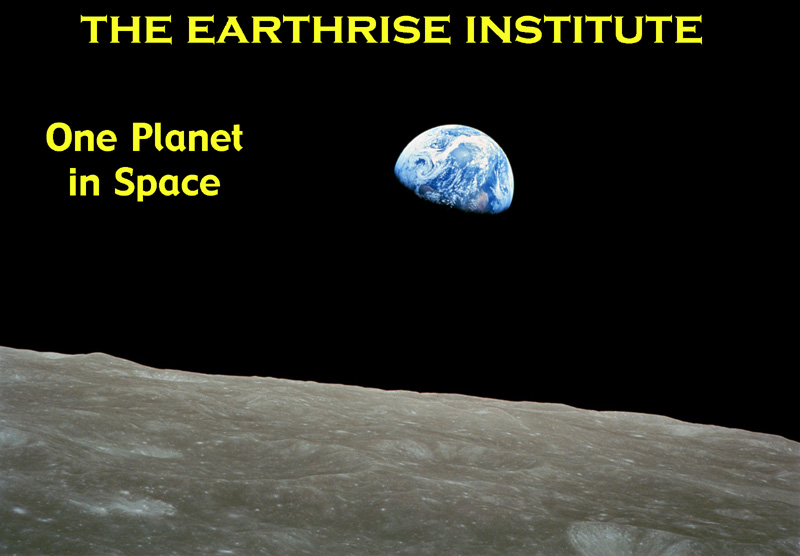
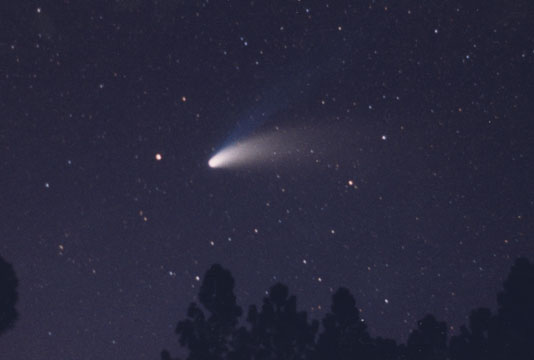
TALLY ENTRIES 761-770
As I have been discussing in numerous previous entries, and as I wrote in the text of my new "Comet Page," at the end of 2024 I "retired" from systematic visual comet observing, after 55 years at this endeavor and with my lifetime comet tally standing at 760. But as I also wrote in the new page, for at least the near-term future I am not walking away from visual comet observing altogether, but will continue to make efforts to observe bright and/or interesting comets that might comet along, although this will be on an occasional rather than a systematic basis. (I also expect to continue my imaging activities via the Las Cumbres Observatory network and my collaboration with its Global Sky Partners educators' forum.) As I have done for the past several years, I will continue to write up descriptions of any additional comets I add to my tally, and post them to these pages.
My first "post-retirement" tally addition certainly qualifies as a "bright and/or interesting" comet. It was discovered on April 5, 2024 by the ATLAS program's Chile telescope, a 19th magnitude object in southern circumpolar skies near a declination of -74.5 degrees. I obtained my first set of images of it via the LCO network five days later, and the astrometrical measurements from this set and another set of images I obtained on the 16th were included in the comet's discovery announcement. Even as early as that second set of images I could detect a short tail extending towards the north-northwest.
As soon as the first orbital calculations were published, Comet ATLAS' extremely small perihelion distance called almost immediate attention to it. A comet approaching that close to the sun might very well not survive perihelion passage, however as additional observations and calculations began to show that Comet ATLAS is apparently not a first-time visitor from the Oort Cloud -- the previous return having taken place approximately 190,000 years ago -- these seemed to suggest that there was at least some chance it might survive perihelion and, conceivably, put on a respectable show. The comet is traveling in a steeply-inclined retrograde orbit (inclination 117 degrees) and, unfortunately for those of us in the northern hemisphere, the orbit is oriented such that the comet both approaches and recedes from the sun from almost directly south of it, and would only be north of the sun, and accordingly accessible from the northern hemisphere, for a very brief interval around perihelion, when, of course, it would be located very close to the sun.
I continued to image Comet ATLAS via LCO on a semi-regular basis up through the end of August (after which its elongation became too small for the LCO telescopes to access); by my last set of images it had brightened to about 17th magnitude and was displaying a distinct tail several arcminutes long. The earliest visual observations of which I'm aware were made by observers in the southern hemisphere in late October, which indicated a brightness near 12th magnitude -- as much as two magnitudes brighter than expected, which in turn suggested a higher probability of surviving perihelion passage. The southern hemisphere observers continued to make additional observations into early November, which indicated a slight brightening, but shortly thereafter the comet went into conjunction with the sun (roughly 28 degrees south of it) and, for a time at least, observations were no longer possible.
Comet ATLAS began emerging into the southern hemisphere's morning sky around the beginning of December, although it remained at a small elongation -- initially around 20 degrees, decreasing to 18 degrees by month's end. Observations continued to show it running about two magnitudes brighter than originally expected, and by the end of 2024 observers in the southern hemisphere were reporting brightnesses around 6th magnitude. A few days later, however, the comet underwent a distinct outburst, to about 2nd magnitude, and despite an elongation of only 16 degrees several observers reported naked-eye sightings. Comet ATLAS continued to brighten from that point as it approached the sun, being about 1st magnitude when it began disappearing into morning twilight around January 11. By this time the comet had traveled far enough north such that observers in the northern hemisphere also began reporting observations and images.

2.jpg) LEFT: The final image I took of Comet ATLAS via the Las Cumbres Observatory network, obtained August 29, 2024 from the LCO facility at Cerro Tololo Inter-American Observatory in Chile. RIGHT: Comet ATLAS as photographed by astronaut Donald Pettit aboard the International Space Station on January 11, 2025. Courtesy NASA.
LEFT: The final image I took of Comet ATLAS via the Las Cumbres Observatory network, obtained August 29, 2024 from the LCO facility at Cerro Tololo Inter-American Observatory in Chile. RIGHT: Comet ATLAS as photographed by astronaut Donald Pettit aboard the International Space Station on January 11, 2025. Courtesy NASA.
Beginning on January 11, Comet ATLAS entered the field-of-view of the LASCO C3 coronagraph aboard SOHO, where it would remain for the next four days. Its high brightness in the LASCO images rather strongly suggested that it might be visible during daytime, and, indeed, several observers soon successfully took daytime images and/or reported successful daytime observations. Eighteen years ago I had used a 20-cm SCT and altitude/azimuth offsets from the sun to make successful daytime observations of Comet McNaught C/2006 P1 (no. 395), and I decided I would use the same instrument and procedure to attempt daytime observations of Comet ATLAS. Bad weather and clouds precluded any realistic attempts for a couple of days, but, finally, on January 14 I had clear skies, and shortly after 11:20 A.M. I managed to spot the comet -- then at an elongation of just under 7 degrees -- although I lost it in the bright sky after about a minute. A little less than an hour and a half later I spotted it again, and successfully followed it for the next half-hour. It appeared as a bright central condensation with a faint trace of coma and the beginnings of a slightly curved tail. Under the circumstances the making of a formal brightness measurement would be somewhat problematical, but the comet definitely appeared fainter than I remember for Comet McNaught, and I accordingly "guesstimated" the brightness as being near magnitude -2.
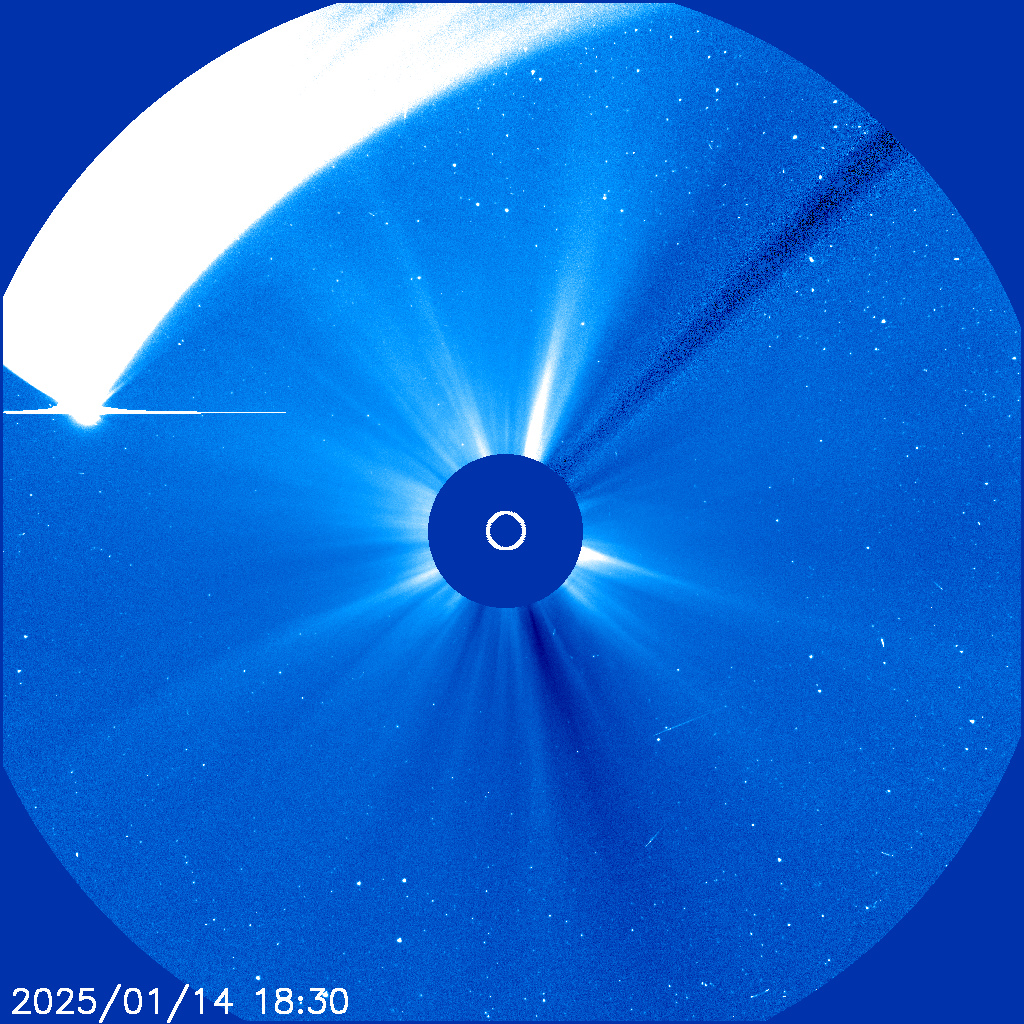
 LEFT: Comet ATLAS in the LASCO C3 coronagraph aboard SOHO on January 14, 2025, at roughly the same time as my initial sighting. Courtesy NASA/ESA. RIGHT: Daytime image of Comet ATLAS taken by Monika Landy-Gyebnar in Hungary on January 14, 2025, roughly 10 hours before my initial sighting. The comet's appearance in this image approximates what I saw through the 20-cm SCT. Image used with permission.
LEFT: Comet ATLAS in the LASCO C3 coronagraph aboard SOHO on January 14, 2025, at roughly the same time as my initial sighting. Courtesy NASA/ESA. RIGHT: Daytime image of Comet ATLAS taken by Monika Landy-Gyebnar in Hungary on January 14, 2025, roughly 10 hours before my initial sighting. The comet's appearance in this image approximates what I saw through the 20-cm SCT. Image used with permission.
Shortly thereafter Comet ATLAS began emerging into bright twilight in the evening sky, and several observers took images and reported successful observations. I do not have a good horizon in that direction from my home location, so I made arrangements to view the comet on the evening of the 15th from the parking lot of the New Mexico Museum of Space History in Alamogordo (which is located on a mountainside above the city and which has a good view of the far western horizon). Unfortunately, some thick cirrus clouds began moving into the southwestern sky during the hours immediately preceding my observing session, although I nevertheless did set up my 10-cm SCT in case there was some clearing. As things turned out, I did successfully see the comet for about 30 seconds when it passed through a brief gap in the clouds just over 20 minutes after sunset when, at an elongation of just under 10 degrees, it was located some 4 degrees above the horizon. Once it disappeared behind a thick cloud at the bottom of that gap, that was the end of its visibility. The comet exhibited a bright central condensation and the beginnings of a curved tail a few arcminutes long; I would "guesstimate" its brightness as being somewhere near magnitude -1.
For me, Comet ATLAS is already gone. Theoretically it has remained accessible in the evening sky and may continue to be so for a couple of more nights, although it is only marginally higher above the horizon than it was on the 15th, and with less-than-ideal weather prospects (and my reluctance to embark on another two-hour roundtrip drive to Alamogordo for what might very well end up being the proverbial "wild goose chase") I have made no plans for further observation attempts. Furthermore, the comet is plunging southward fairly rapidly -- thus quickly becoming inaccessible again from the northern hemisphere -- and since it is now receding from the sun and Earth it is also fading.
For observers in the southern hemisphere, meanwhile, the conditions for visibility are rapidly improving, and it is entirely possible that they may witness a pretty good show over the next two to three weeks -- indeed, initial reports at this writing do suggest a relatively decent display could be in the works. The comet remains somewhat low in the evening sky, however, with the elongation not going above 30 degrees until almost mid-February and not above 40 degrees until mid-March. It is in conjunction with the sun (48 degrees south of it) at the beginning of April, at which time it will probably be close to fading beyond visual detectability.
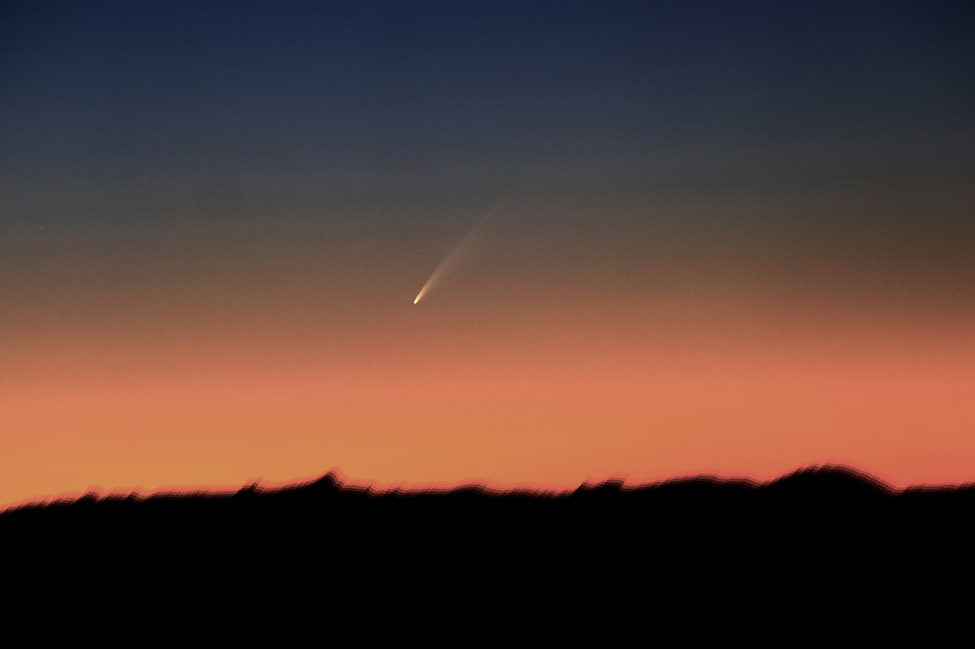 The current view of Comet ATLAS from the southern hemisphere. This image was taken by Rob Kaufman from near Bright, Victoria, Australia on the evening of January 17, 2025. Used with permission.
The current view of Comet ATLAS from the southern hemisphere. This image was taken by Rob Kaufman from near Bright, Victoria, Australia on the evening of January 17, 2025. Used with permission.
This sort-of "extra" comet to my tally is unique and at or near record-breaking in several respects. It has the 4th-smallest perihelion distance of any comet on my tally, and at the time of my first sighting on January 14 its heliocentric distance was 0.119 AU, the smallest heliocentric distance at which I've ever observed a comet. Comet ATLAS becomes only the third comet that I have observed during daytime, a total that includes Comet Hale-Bopp C/1995 O1 (no. 199) which I sucessfully followed for one minute after sunrise one morning before losing it in the bright sky; it is the only comet I have ever added to my tally during daytime. At magnitude -2 it is the 3rd-brightest comet I have ever seen, and it is the brightest comet I have ever observed on my initial observation. Since I never observed Comet ATLAS with my naked eye (or even with binoculars) I don't consider it a "Great Comet" (at least, from my perspective), but the fact I could observe it during daytime does warrant consideration as being among my "best" comets; I accordingly rank it as the 8th-best comet I have ever observed.
INITIAL OBSERVATION: 2025 January 14.84 UT, m1 = -2:, 0.5' coma, DC = 8, 2' tail in p.a. 050 (20 cm SCT, 80x; daytime)
UPDATE (February 5, 2025): Pretty much as expected, Comet ATLAS put on a good show for observers in the southern hemisphere during the latter half of January, pretty much approaching "Great Comet" status. Various reports placed it between 1st and 3rd magnitude, and it exhibited a bright, somewhat curved dust tail at least 15 degrees long. (The extremities of this tail were even detectable from the northern hemisphere, although I never looked for this.) By around January 20, however, it was starting to become clear that the comet's nucleus had disintegrated, and from that point on the comet has appeared more-or-less as a "headless wonder," i.e., still a bright tail but with no real coma.
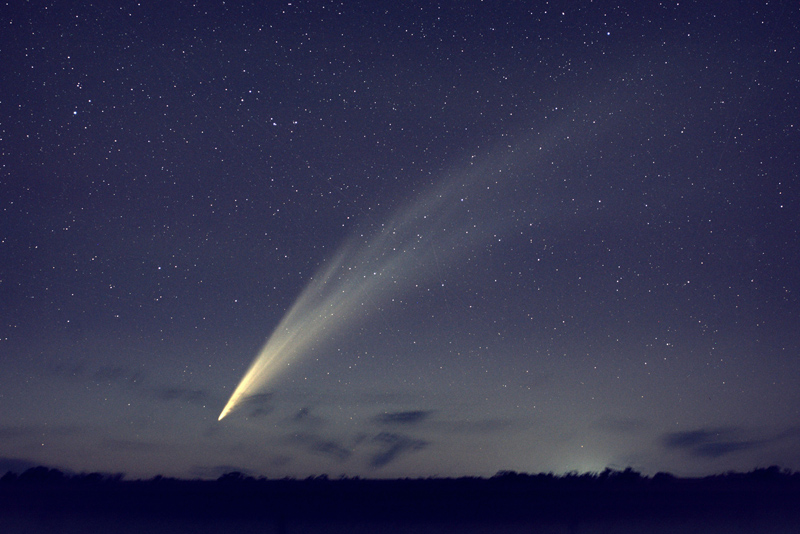
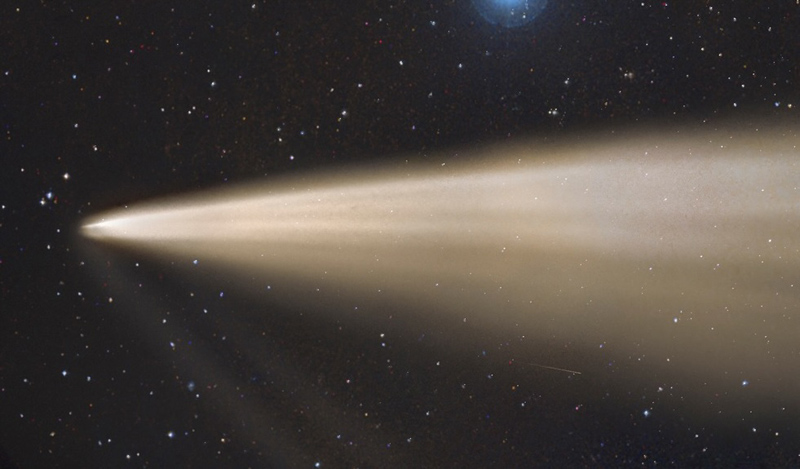 IMAGES OF COMET ATLAS FROM THE SOUTHERN HEMISPHERE. LEFT: January 22, 2025 as photographed by Michael Mattiazzo in Swan Hill, Victoria. RIGHT: The comet's inner regions on January 26, 2025, imaged remotely from Namibia by Gerald Rhemann. There is no actual coma, just tail streamers extending from the comet's front. Both images used with permission.
IMAGES OF COMET ATLAS FROM THE SOUTHERN HEMISPHERE. LEFT: January 22, 2025 as photographed by Michael Mattiazzo in Swan Hill, Victoria. RIGHT: The comet's inner regions on January 26, 2025, imaged remotely from Namibia by Gerald Rhemann. There is no actual coma, just tail streamers extending from the comet's front. Both images used with permission.
By late January the comet's overall brightness had faded to about 4th magnitude, although it was still readily visible to the naked eye, with the tail's appearance being likened to that of a "searchlight beam." Now that the moon is in the evening sky the show is essentially over; by the time the moon leaves the evening sky later this month there may not be very much of the comet left to see.
762. COMET SWAN C/2025 F2 Perihelion: 2025 May 1.16, q = 0.333 AU
Thus far, this current year of 2025 has been "interesting," often in the sense of the ancient Chinese curse, and at times it almost seems surreal. While I have usually avoided commenting on political issues in these tally entries, I feel compelled to say that I am ashamed of and disgusted at the havoc wreaked on this country and the world at large by the current Presidential administration -- which I foresaw in the aftermath of the election last November (and commented on at the end of a previous entry). Although I have not -- yet, at least -- been personally affected much in any direct sense, many, many others are not so fortunate, and it is difficult for me to maintain any kind of optimism in the current climate. Hopefully we will find a way to get through this, but any thoughts I have previously had about a positive future for humanity have been all but shattered, at least for now. I would love to be proven wrong, but . . . In any event, I continue to take things one day at a time, and am continuing my collaboration with the Las Cumbres Observatory Global Sky Partners, since that, at least, seems to offer me some hope for the future.
As any readers who have been with me for any significant time may recall, I "retired" from systematic visual observing, including visual comet observing, at the end of 2024. I have nevertheless continued to make observations on an occasional basis, which included my observations of the previous tally entry in January, and one observation of Comet 29P/Schwassmann-Wachmannn 1 (no. 498) -- which had just undergone a new outburst -- on the evening of February 2 in order to mark the 55th anniversary of my first comet observation. (I also observed the total lunar eclipse on the night of March 13-14, although the sky conditions were less than ideal.) I did not make any visual comet observations at all during the month of March, the first calendar month I have failed to observe any comets since September 1981 -- over 43 years ago. Part of the reason for this is that the overall cometary activity in the sky has been quite low lately -- although 29P has certainly been observable -- but in keeping with my "retirement" I have not made the effort I would have made in previous years.
My second post-"retirement" tally addition is a comet that was initially detected in images taken by the SWAN ultraviolet telescope aboard the SOHO spacecraft beginning on March 22, 2025, independently by three champion SWAN comet-hunters: Vladimir Bezugly in Ukraine, Rob Matson in California, and Michael Mattiazzo in Victoria. Because of the poor positional and time resolution of the SWAN images, as well as to a relatively small elongation from the sun, it took a while before ground-based observers were able to locate the comet, but once it was found shortly after the beginning of April numerous observations began to be reported, most of these indicating it was around 10th magnitude. After an orbit was computed it was found as a very faint object in images taken by the Pan-STARRS survey (as well as in one DECam image) to as far back as early September 2024. Meanwhile, several ground-based observers noted that the comet apparently underwent a distinct increase in brightness, to about 8th magnitude, around April 6.
From my own perspective, although I was aware of the discovery quite early on, the comet's low elongation (28 to 29 degrees) rendered it inaccessible from my main home observing site (since I have trees in that direction), and this, combined with my "retirement" and the initial large uncertainty as to its actual location, made me reluctant to expend any effort to travel to another location for any observation attempts. Furthermore, a series of several consecutive cloudy nights, which included a non-trivial snowstorm on the night of April 4-5, precluded any such attempts anyway. I finally had clear skies on the morning of the 7th -- although in the wake of the earlier storm the temperature was well below freezing, which is unusually cold for early April -- and in light of the reports of the comet's recent brightening I took the 4-inch SCT to a nearby location, and successfully detected the comet shortly after it rose above the trees, however I encountered some problems with my overall setup that prematurely ended my observation after only about one minute. I tried again on the following morning and had a pretty good observation; the comet appeared as a rather condensed object of magnitude 7 1/2, and I could faintly detect the beginning of the ion tail that is quite prominent on various CCD images I have seen.
Comet SWAN is traveling in a steeply-inclined orbit with an inclination of almost exactly 90 degrees, and appears not to be a first-time visitor from the Oort Cloud, the previous return having taken place 70,000 to 100,000 years ago. It is on the far side of the sun from Earth, and was at its maximum elongation -- just under 29 degrees -- around April 5. It is presently located in the northeastern part of the "Great Square" of Pegasus, some five degrees west-southwest of the star Alpheratz (Alpha Andromedae, the star at the northeastern corner of the "Great Square") and is traveling towards the east-northeast at 1 1/2 degrees per day, passing 40 arcminutes northwest of Alpheratz on April 12. The elongation slowly decreases over the coming days, and the comet is in conjunction with the sun -- 25 degrees north of it -- on April 20, thereafter becoming primarily an evening-sky object, and reaching a maximum northerly declination just north of +35 degrees on April 23 before turning towards the southeast. At the time of perihelion passage the comet is closest to Earth (0.96 AU) and will be located in northwestern Taurus five degrees northwest of the Pleiades star cluster (M45), when it will be traveling towards the southeast at three degrees per day and passing one degree northeast of the Pleiades the following day; it will then be near its minimum elongation of just over 19 degrees. After that it turns more towards the south-southeast and slows down as it recedes from the sun and Earth, and the elongation slowly increases, although it very quickly becomes accessible only from the southern hemisphere, traveling south of the celestial Equator just after mid-May.
At this writing the moon is approaching its Full phase and is washing out the morning sky. Whether or not I observe Comet SWAN again depends largely on how it brightens during the next few weeks. If it brightens "normally" from the brightness I observed on the 8th this would suggest a possible maximum brightness near magnitude 3.5 around the time of perihelion passage, which would make travel to an observing site that could access something at the small elongation at perihelion worthwhile (especially on the evening of May 2, when it will lie quite close to the Pleiades, making it easily locatable). The fact that it is apparently not a first-time visitor from the Oort Cloud would seem to be a good sign, but on the other hand I have read very recent reports that suggest the comet may be fading, which in turn might suggest that the recent brightening was due to an outburst, from which it is now starting to subside. If that is the case, the comet may well be fainter when it passes through perihelion, and conceivably could even disintegrate as it approaches that point. We will just have to wait and see what the comet does . . . just as we will have to wait and see if this country, and the world, can pull itself out of the mess it is currently in.
SECOND OBSERVATION: 2025 April 8.47 UT, m1 = 7.5, 2.5' coma, DC = 7, 12' tail in p.a. 315 (10 cm SCT, 40x)
UPDATE (May 4, 2025): It appears that the upsurge in brightness that Comet SWAN underwent in early April -- which contributed in part to my being able to observe it at that time -- was indeed an outburst, and in fact was apparently its "last hurrah." According to various reports and images from other observers it faded from that point, and moreover began to grow less condensed and more diffuse, indicating that it was disintegrating. By the end of April images were showing it as nothing more than a faint, smeared-out cloud of debris, and accordingly there has been no reason to attempt any observations in the evening sky after its perihelion passage. Since we have been experiencing rain storms (and the accompanying cloudy weather) here in New Mexico during this time, it's all a rather moot issue anyway.
763. COMET ATLAS C/2025 K1 Perihelion: 2025 October 8.44, q = 0.334 AU
Time marches on in this politically and socially surreal year of 2025. For these past few months I have been settling into my "retirement" from systematic visual astronomical observing, and have been in the process of developing my new "normal." For the time being, anyway, within that new "normal" I have decided not to walk away from visual observing entirely, and for example I did grab a couple of observations of the above comet (and, as I wrote in that entry, I also observed the total lunar eclipse in March); also, during late June and early July I made a handful of binocular observations (and one naked-eye observation) of the recent somewhat-bright nova in Lupus. On the other hand, I had not taken out the 41-cm telescope in over 5 1/2 months, although this is probably due in significant part to the absence of any even somewhat-bright comets in our sky.
This past July 23 marked the 30th anniversary of my discovery of Comet Hale-Bopp C/1995 O1 (no. 199). Since there are now a few incoming comets that are approaching visual detectability, I was strongly considering marking the occasion by taking out the 41-cm telescope and attempting observations of one or more of these comets. However, not unexpectedly since we are in the midst of our annual summer monsoon here in New Mexico, that night and the next several nights were cloudy. Finally, a few days later I had a couple of consecutive clear nights, and on those nights I added a couple of incoming (currently faint) comets to my tally, and in keeping with my post-"retirement" new "normal" I will probably observe these (and perhaps a couple of others) on an occasional basis during the coming months.
The first of these comets was discovered on May 24, 2025 by the ATLAS program's telescope in Chile. Although initially reported as asteroidal in appearance, in images I took via the Las Cumbres Observatory network's telescope at the South African Astronomical Observatory as soon as a day later I could tell that it was a comet. Ultimately I was able to submit three sets of astrometric observations and two reports of cometary activity that were included on its discovery announcement.
The comet has brightened fairly rapidly since its discovery, and has exhibited a distinct tail on many CCD images I've seen, including some additional LCO images I have occasionally taken. On a set of images I took shortly after mid-July the comet appeared bright enough to suggest that it might be worth visual attempts, and on the evening of the 25th I was able to detect it as a small and fairly condensed object near magnitude 13 1/2, that exhibited distinct motion (within a fairly rich star field) over half an hour.
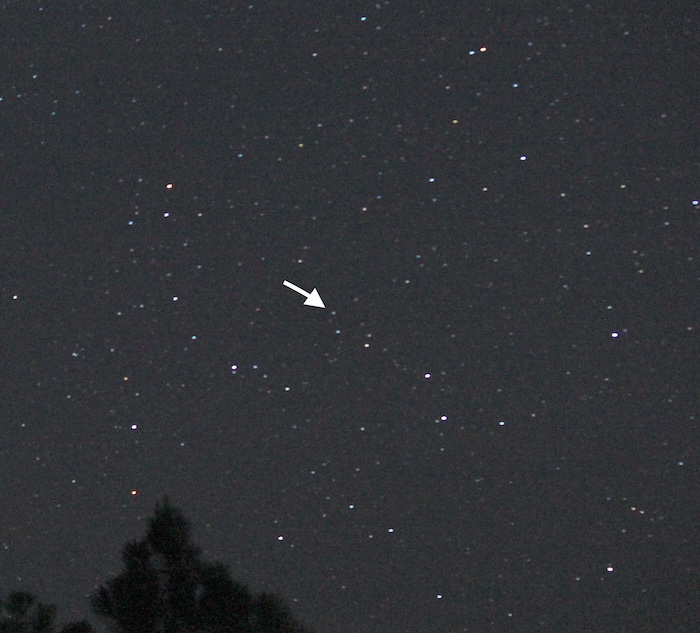
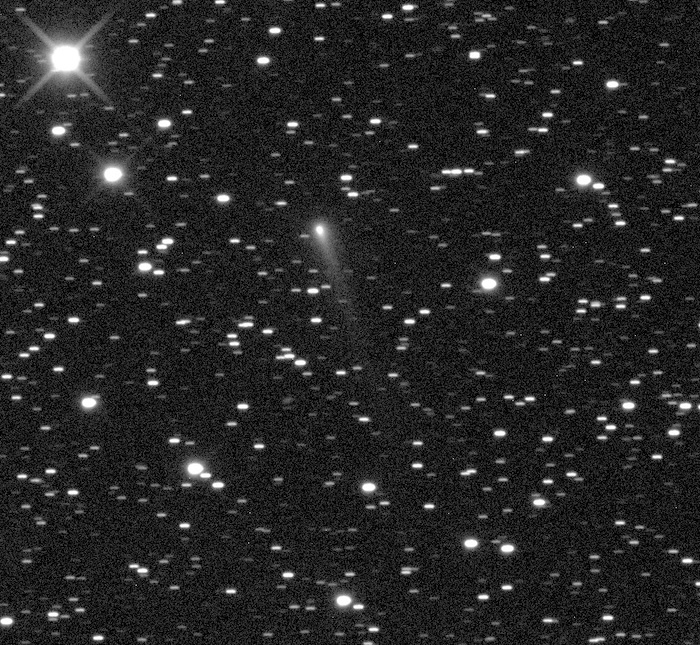 LEFT: Photograph I took of Nova Lupi 2025 on the evening of June 16, 2025. I estimated its visual brightness at magnitude 6.1. Three nights later I estimated the brightness at magnitude 5.2, and could faintly see it with my naked eye. RIGHT: Image I took of Comet ATLAS C/2025 K1 on July 19, 2025 -- just over six nights before I first observed it visually -- via the Las Cumbres Observatory facility at Teide Observatory in the Canary Islands.
LEFT: Photograph I took of Nova Lupi 2025 on the evening of June 16, 2025. I estimated its visual brightness at magnitude 6.1. Three nights later I estimated the brightness at magnitude 5.2, and could faintly see it with my naked eye. RIGHT: Image I took of Comet ATLAS C/2025 K1 on July 19, 2025 -- just over six nights before I first observed it visually -- via the Las Cumbres Observatory facility at Teide Observatory in the Canary Islands.
Comet ATLAS is traveling in a moderately-inclined retrograde orbit (inclination 148 degrees) and is currently near opposition. It is located in central Vulpecula just over a degree north of the Dumbbell Nebula M27 and traveling almost due westward at two degrees per day. Gradually curving somewhat towards the southwest, in early August it enters Hercules, and passes 0.58 AU from Earth on August 13, at which time it will be located 2 1/2 degrees north of the star Rasalhague (Alpha Ophiuchi) and traveling at almost three degrees per day. Thereafter it travels through Serpens Caput and Libra before entering Virgo in early September, by which time it is disappearing into evening twilight.
Comet ATLAS does not seem to be all that bright intrinsically, and that together with the relatively small heliocentric distance it will occupy at perihelion suggests a realistic possibility that it will not survive that event. If it does survive, it should reappear in the morning sky towards the end of October, when it will be located in far western Virgo and traveling towards the north-northwest. Over the next few weeks it climbs rapidly northward, traversing Leo and crossing into Ursa Major, entering northern circumpolar skies during the latter part of November. The comet is nearest Earth (0.40 AU) on November 25, at which time it will be located roughly three degrees northeast of the star Tau Ursae Majoris and traveling at close to 4 1/2 degrees per day. It reaches a peak northerly declination of +75 degrees at the end of November and then slows down and begins traveling towards the south-southwest, leaving northern circumpolar skies during the second week of December. After passing just to the east of the "W" of Cassiopeia it enters Andromeda in mid-December, and passes three degrees east of the Andromeda Galaxy M31 right around Christmas.
Especially in light of its questionable prospects of survival, plus the fact that it appears to be a "new" comet from the Oort Cloud, making any brightness predictions for Comet ATLAS would seem to be a problematical exercise. It possibly could reach 11th magnitude or thereabouts by the time it enters evening twilight in September, and if it should survive perihelion it might become bright enough -- say, 8th magnitude -- to be visible in binoculars after it emerges into the morning sky. Conceivably, especially if it undergoes a fragmenting episode when near perihelion, it might reach faint naked-eye visibility, although I consider this prospect pretty unlikely. As is the case with just about any incoming long-period comet, we will just have to wait and see what happens.
INITIAL OBSERVATION: 2025 July 26.23 UT, m1 = 13.4, 0.9' coma, DC = 6-7 (41 cm reflector, 70x)
UPDATE (October 9, 2025): I successfully observed Comet ATLAS one additional time, during the latter part of August, when it had brightened to about 12th magnitude and telescopically was beginning to exhibit the dust tail that has been rather prominent on CCD images. According to various reports I've read, primarily from observers in the southern hemisphere, it had brightened by an additional magnitude or so by the time it disappeared into evening twilight towards the end of September.
As I discussed above, there has been considerable uncertainty as to whether or not Comet ATLAS would survive its close perihelion passage to the sun. However, as it approached perihelion, for a couple of days beginning on October 6 Comet ATLAS was visible as a 9th-magnitude object traversing the southernmost regions of the field-of-view of the LASCO C3 coronagraph aboard SOHO, and has also been visible as a moderately bright object in images obtained with the SWAN ultraviolet telescope, also aboard SOHO. At this writing, then, it appears distinctly possible that Comet ATLAS might indeed survive its perihelion, and if it does it should be emerging into our morning sky towards the end of October, as described above.
UPDATE (October 29, 2025): Comet ATLAS has indeed survived perihelion passage! The first ground-based post-perihelion images were obtained around October 18 and 19, at which time the comet's elongation was near 23 degrees; these showed it as a bright and condensed object between 9th and 10th magnitude, with a straight, distinct tail. Additional images over subsequent days continued this same basic appearance, and when I was able to observe the comet visually on the morning of October 28 -- at which time the elongation had increased to 39 degrees and it was deep in zodiacal light -- I could see it easily near magnitude 9 1/2, with a small condensed coma and a straight tail several arcminutes long.
Over the coming few weeks Comet ATLAS continues climbing higher into the morning sky according to the scenario described above. Brightness predictions continue to remain uncertain, but provided the comet doesn't begin some kind of delayed disintegration it may maintain something close to its present brightness up through the time of its closest approach to Earth in late November, but will likely fade quite rapidly afterwards.
Meanwhile, a sad event in my personal life took place shortly before I obtained this observation of Comet ATLAS. I plan to discuss this in the write-up for my next tally addition, which should take place sometime in November.
MOST RECENT OBSERVATION: 2025 October 28.50 UT, m1 = 9.6, 1.2' coma, DC = 7-8, 6' tail in p.a. 310 (41 cm reflector, 70x)
UPDATE (November 26, 2025): It appears that Comet ATLAS did not survive its close perihelion passage unscathed after all. While it has maintained its brightness quite well, and its bright and distinct tail gives it an impressive telescopic appearance, it began exhibiting some signs of disintegration pretty early on, beginning with a "hammerhead" appearance that often indicates a disintegrating comet. Then, by the second week of November there were reports of different fragments in the nucleus, which soon became rather distinct on numerous CCD images that were taken during subsequent days. At least two fragments -- designated "B" and "C" -- appeared in addition to the primary component, and when I observed the comet visually on the morning of the 14th I could detect the "B" fragment without much difficulty. Since then, "B" appears to have dissipated, while "C" has become brighter, and there are also signs of at least one additional fragment. When I observed the comet visually yesterday morning I was able to detect "C" and also saw hints of one other possible fragment.
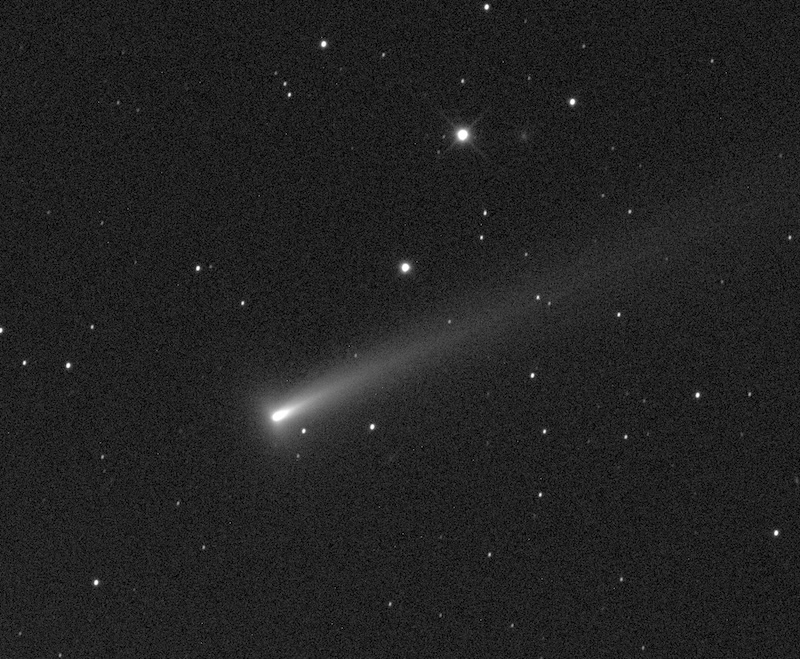
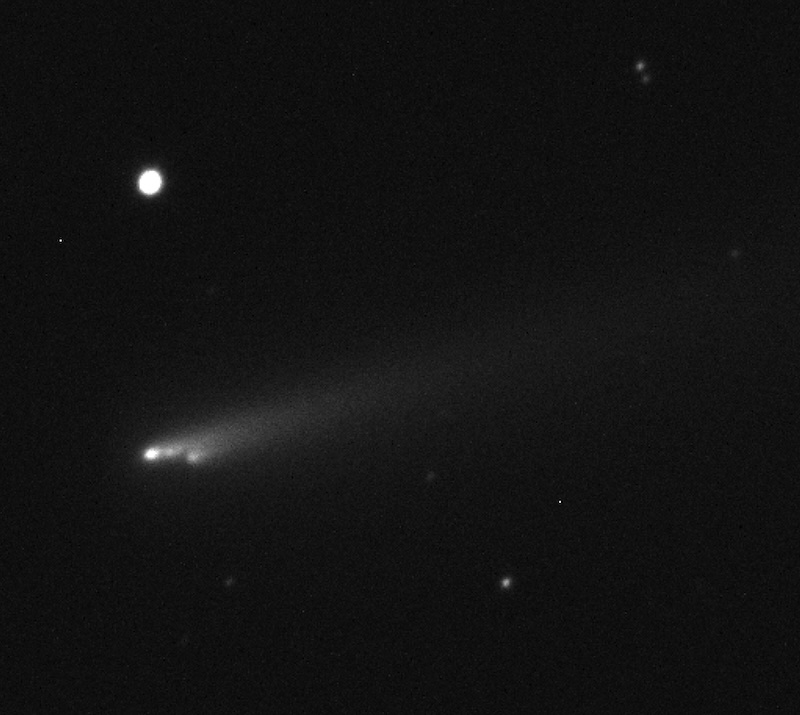 Las Cumbres Observatory images I have recently taken of Comet ATLAS C/2025 K1. LEFT: November 7, 2025, from the LCO facility at Teide Observatory in the Canary Islands. The coma displays the "hammerhead" shape that often indicates the beginning of the disintegration process in comets. RIGHT: Short exposure taken on November 21, 2025, from the LCO facility at McDonald Observatory in Texas. The fragments are, left to right, "A" (the primary), "C," and "B." As of this writing "B" has essentially dissipated while "C" has become noticeably brighter.
Las Cumbres Observatory images I have recently taken of Comet ATLAS C/2025 K1. LEFT: November 7, 2025, from the LCO facility at Teide Observatory in the Canary Islands. The coma displays the "hammerhead" shape that often indicates the beginning of the disintegration process in comets. RIGHT: Short exposure taken on November 21, 2025, from the LCO facility at McDonald Observatory in Texas. The fragments are, left to right, "A" (the primary), "C," and "B." As of this writing "B" has essentially dissipated while "C" has become noticeably brighter.
What we will see from Comet ATLAS during the next few weeks depends upon how the disintegration process proceeds. It may eventually dissipate completely, or, conceivably, the primary fragment, and thus the overall comet itself, may remain intact. In any event, the comet has just now passed its closest approach to Earth and, more than likely, will start to fade fairly rapidly as it pulls away from our planet and in the meantime transfers over to the evening sky.
MOST RECENT OBSERVATION: 2025 November 25.45, m1 = 9.8, 1.3' coma, DC = 7, 17' tail in p.a. 260 (41 cm reflector, 70x)
764. COMET 240P/NEAT Perihelion: 2025 December 19.95, q = 2.122 AU
This is the second of two comets (that I alluded to in the previous entry) that I added to my tally in order to -- belatedly -- mark the 30th anniversary of my discovery of Comet Hale-Bopp C/1995 O1 (no. 199). It is a short-period object, originally discovered by the NEAT program in late 2002, that I have seen on two previous returns: I observed it in late 2010 (no. 483) as a very faint object during the course of "Countdown," and I observed it again in 2017 (no. 627) when it underwent an apparent outburst nine months before perihelion. In the descriptions I wrote for both of those returns I mentioned that the viewing geometry during this year's return is especially favorable, however in view of my "retirement" from systematic visual observational activities, and especially in light of the seemingly erratic behavior it exhibited during its 2017-18 return, I considered it unlikely I would be observing it this time around.
On its current return Comet 240P was recovered as long ago as June 13, 2024 by the Pan-STARRS program in Hawaii. During recent weeks I have seen brightness reports as well as various images that suggested it is currently somewhat bright, and shortly after mid-July I took some images of my own via the Las Cumbres Observatory network that, in addition to showing a distinct tail, suggested it might be bright enough to attempt visually. On the morning of July 27 I successfully detected it as a relatively vague and diffuse object slightly brighter than 14th magnitude.
The comet is currently located in far northwestern Eridanus about two degrees south of the star 94 Ceti and is traveling slightly northward of due east at approximately 20 arcminutes per day. It reaches its stationary point during the second week of October, after which it crosses into Taurus and begins retrograde (westward) motion. After going through opposition shortly after mid-November it is nearest Earth (1.16 AU) on the 24th of that month, then passes through its other stationary point in early January 2026, when it briefly crosses into Aries and resumes direct (eastward) motion. Now traveling towards the east-northeast, the comet crosses back into Taurus at the end of January and passes two degrees north of the Pleiades star cluster (M45) in mid-February.
If Comet NEAT behaves "normally" it should brighten by perhaps two magnitudes by around the time it is at opposition and nearest Earth, and remain visually detectable until perhaps March 2026. But, given its past behavior there is no real way to know at this time whether or not it will in fact behave "normally;" it could, conceivably, be even brighter when it is near opposition and perihelion, or (I would think more likely) be distinctly fainter, and I would not rule out the possibility that it will fade dramatically and even disintegrate by that time. The only real way to know is to see what it does, and I suspect I will continue to take occasional images of it via LCO and, if these indicate it is worthwhile, might continue to make occasional visual observations as well.
INITIAL OBSERVATION: 2025 July 27.42 UT, m1 = 13.7, 1.0' coma, DC = 1-2 (41 cm reflector, 229x)
UPDATE (October 16, 2025): I have managed to obtain a couple of more observations of Comet NEAT since my initial sighting in late July, although since it is quite faint and until now has primarily been visible in the morning sky, it has been a rather low-priority object for me. As of my recent observation at this writing, which I obtained in late September, it had brightened slightly, to about 13th magnitude.
Meanwhile, in early October Vivian Carvajal with the Catalina Sky Survey in Arizona reported her discovery of a faint companion comet traveling alongside Comet NEAT -- obviously a fragment of the primary object. After I read of her report I examined images I had previously taken of Comet NEAT via the Las Cumbres Observatory network, and succesfully found this companion object on images I had taken on September 17, although I have been unable to find it on images I took in late July. I have just recently taken some additional images of Comet NEAT, including some with longer exposure times, and these show the fragment -- now designated as Component "B" -- rather well, with a tail structure that appears to mimic that of the primary component. The fragment is about 18th magnitude, obviously too faint for any meaningful visual attempts.

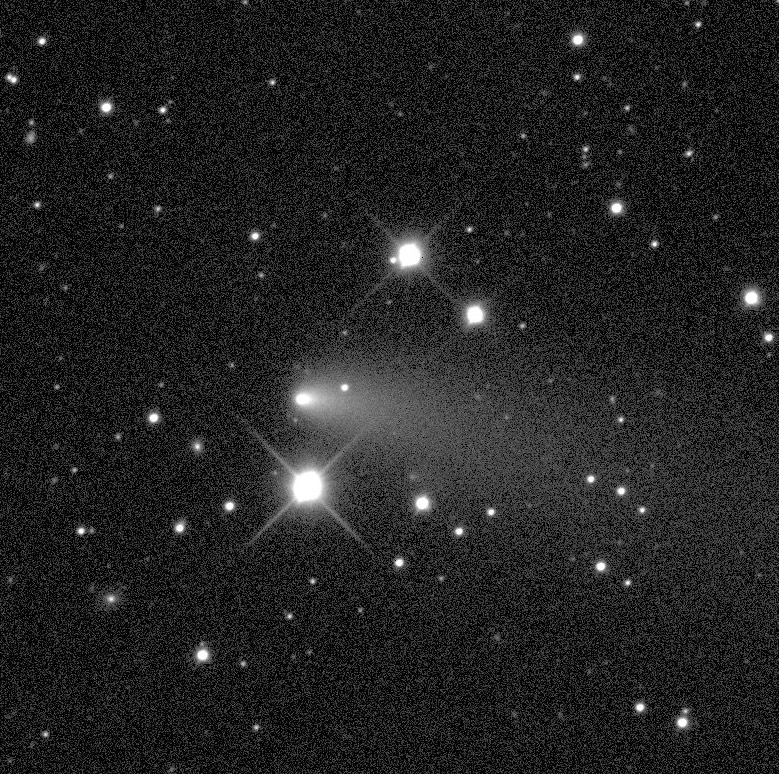 Images (cropped) of Comet 240P/NEAT I have taken via the Las Cumbres Observatory (LCO) network. LEFT: September 17, 2025, from the LCO facility at Cerro Tololo Inter-American Observatory in Chile. Component "B" is indicated by an arrow. RIGHT: October 16, 2025, from the LCO facility at Haleakala Observatory in Hawaii. Component "B" is to the lower right of the primary component, above (and slightly to the left) of a somewhat bright star, and the beginning of a tail extending towards the right (west) can be seen.
Images (cropped) of Comet 240P/NEAT I have taken via the Las Cumbres Observatory (LCO) network. LEFT: September 17, 2025, from the LCO facility at Cerro Tololo Inter-American Observatory in Chile. Component "B" is indicated by an arrow. RIGHT: October 16, 2025, from the LCO facility at Haleakala Observatory in Hawaii. Component "B" is to the lower right of the primary component, above (and slightly to the left) of a somewhat bright star, and the beginning of a tail extending towards the right (west) can be seen.
At this writing there have been no formal published analyses of the history of Component "B," including when it might have separated from the primary. I am curious as to whether or not the fragmenting episode might have occurred during the previous return, in 2017-18, when, as I indicated in my write-up for that return (no. 627) the comet underwent a major outburst nine months before perihelion passage. The astrometry from the images that I and other observers have been taking will hopefully help in the process of shedding some light on this question within the not-too-distant future.
MOST RECENT OBSERVATION: 2025 September 21.40 UT, m1 = 13.2, 1.2' coma, DC = 2 (41 cm reflector, 70x)
765. COMET LEMMON C/2025 A6 Perihelion: 2025 November 8.54, q = 0.530 AU
Another potentially interesting comet joins my tally in my post-"retirement" era. It was discovered by Carson Fuls with the Mount Lemmon Survey in Arizona on January 3, 2025, initially appearing as a very faint asteroidal object near 21st magnitude (hence the name "Lemmon"). I managed to obtain two sets of observations via 1-meter telescopes of the Las Cumbres Observatory network in late January that were eventually included on the comet's discovery announcement that wasn't issued until shortly after mid-February. Afterwards it remained very faint for quite some time; I managed to obtain one additional set of LCO images in late March, and only one set of observations from anywhere else (less than a week later) was reported before the comet entered evening twilight en route to conjunction with the sun in early July.
Comet Lemmon began emerging into the morning sky around the beginning of August, and the first reported observations indicated a brightness near 14th magnitude -- considerably brighter than what its pre-conjunction brightness might suggest. Various observers then reported that it brightened quite rapidly during the next few weeks. Because I have trees in that direction from my home observing site, and also because of typical monsoon conditions, it was a while before I was able to attempt any observations of my own, but when I was finally able to do so, on the morning of August 29 -- at which time the comet's elongation had increased to 43 degrees -- I easily detected it at 11th magnitude. It appeared relatively diffuse, although with what is apparently a small, distinct condensation.
Comet Lemmon is traveling in a moderately-inclined retrograde orbit (inclination 144 degrees) with an approximate orbital period of 1340 years (although planetary perturbations it is encountering during its current passage through the inner solar system will shorten its orbital period by almost two centuries). It is currently located in northeastern Gemini five degrees east of the bright star Castor and is traveling towards the east-northeast at slightly less than half a degree per day. Over the next few weeks it accelerates as it passes through Lynx, Leo Minor, Ursa Major, Canes Venatici, and Bootes, reaching a peak northerly declination of +42.2 degrees on October 10 before going through inferior conjunction (45 degrees north of the sun) nine days later. The comet passes 0.60 AU from Earth on October 21, at which time it will be fairly low in the northwestern evening sky, being located in central Bootes and traveling towards the southeast at (briefly) somewhat over four degrees per day. Within three days it enters Serpens Cauda and then crosses into Ophiuchus at the end of October, and within another one to two weeks it disappears into evening twilight en route to conjunction with the sun in early December. The comet remains hidden in sunlight for another few weeks before gradually emerging into the southern hemisphere's morning sky around mid-January 2026.
The recent rapid brightening that Comet Lemmon has exhibited is behavior that is not unheard-of for intermediate-period comets, although how long it maintains this trend remains to be seen. At this time a peak brightness of perhaps 7th magnitude, and thus relatively easy visibility in binoculars, around the time of its closest approach to Earth would seem to be a reasonable expectation, although it is certainly within the realm of possibility that it might achieve dim naked-eye visibility near 4th or 5th magnitude. (I would be quite surprised if it becomes much brighter than that.) The comet reaches a maximum phase angle of 105 degrees on October 25 and thus there is a possibility of some brightness enhancement via forward scattering of sunlight, although thus far its overall composition appears to be pretty "gassy" and there hasn't been much evidence of any substantial dust content. In any event, although the viewing geometry is not especially great and the show will likely be fairly brief, there appears to be a reasonable chance that I, and other comet observers, might have a somewhat bright comet to enjoy in a couple of months' time.
Meanwhile, I am currently marking the anniversary of one of the most important astronomical observations I have ever made in my life. It was exactly 50 years ago, on the pleasant summer evening of August 31, 1975, when, having just recently begun my Senior year of High School, I was lying on my back in the front yard of our family home on the southern outskirts of Alamogordo, New Mexico, listening to tunes on the radio and looking up and contemplating the nighttime sky. I happened to notice a fairly bright star near the star Deneb in the constellation Cygnus -- which was almost directly overhead -- that I didn't recall ever seeing before and that demonstrably altered the star pattern I thought I knew as Cygnus. I examined the star for a few minutes, but then dismissed it as a star that had always been there and that, for whatever reasons, I had never noticed before.
The next day, there was an article in the local newspaper about the "Bright New Nova in Cygnus." What I had inadvertently seen, and then dismissed, was Nova Cygni 1975 (aka V1500 Cygni), the brightest nova that has appeared in my lifetime, and, indeed, as of now the brightest nova that has appeared anywhere in the sky for over 80 years. It had initially appeared over two days earlier, and thus even if I had followed up on it and then reported it, I wouldn't have received any credit for a "discovery." But I learned my lesson, and ever since then, whenever I have come across anything that seemed "strange" or that I didn't recall seeing before, I have always taken a few minutes to check it out. 99% of the time whatever I have seen turns out to be something mundane that has always been there but that, for whatever reasons, I had just never noticed or paid attention to before. But it is that other 1% that can make all the difference . . . and on another summer night 20 years later, that long-ago lesson I learned paid off.
INITIAL OBSERVATION: 2025 August 29.46 UT, m1 = 11.0, 3.5' coma, DC = 4-5 (41 cm reflector, 70x)
UPDATE (October 18, 2025): Comet Lemmon continued its rapid brightening, and by the beginning of October I could easily detect it in 10x50 binoculars at 7th magnitude, accompanied by a short faint tail (which I could trace for almost half a degree through the 41-cm telescope). At this writing it has now become accessible in the evening sky, very low in the northwest during late dusk, and on the evening of October 16 it was readily visible, even in twilight, in the binoculars near 5th magnitude with a 1-degree-long tail. Due to the comet's low elevation -- just a few degrees above the horizon -- and the twilight I was unable to see it with my naked eye.
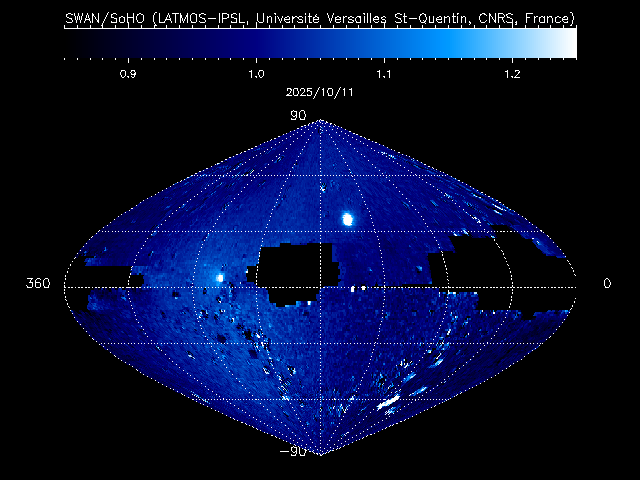
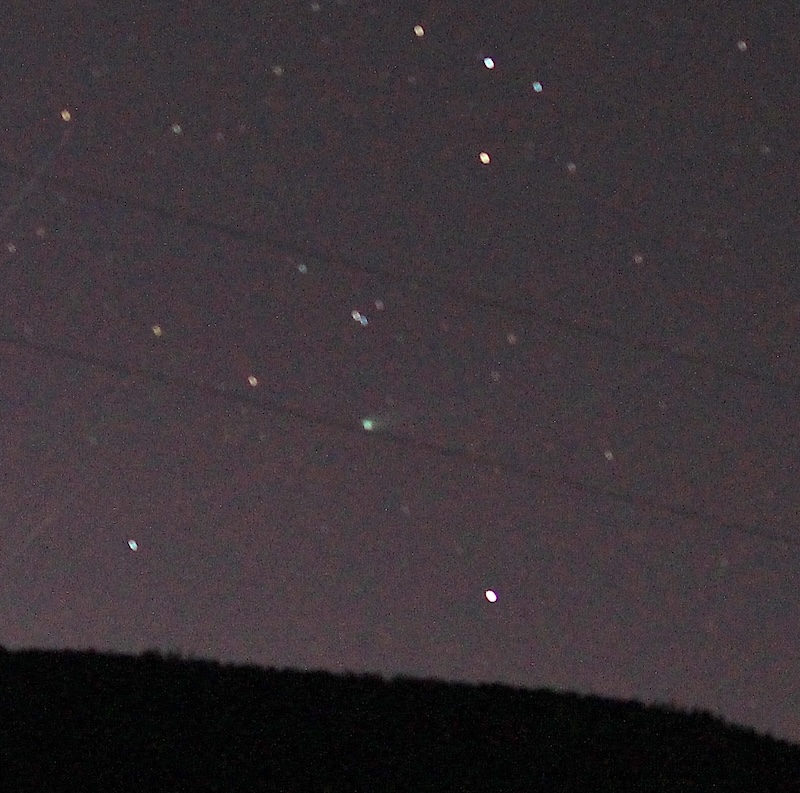 LEFT: All-sky image taken by the SWAN ultraviolet telescope aboard the SOHO spacecraft on October 11, 2025. Comet Lemmon is the bright object to the upper right of the central "hole;" to the left of this "hole" is Comet SWAN C/2025 R2 (no. 766), and along the bottom edge of this "hole," slightly to the right of its mid-point, is Comet ATLAS C/2025 K1 (no. 763) which, as I discussed in a recent update, apparently survived its perihelion passage three days earlier. Courtesy NASA/ESA. RIGHT: Photograph of Comet Lemmon that I took on the evening of October 16, 2025. (I had motored to a site roughly 1 km from my home site in order to have a clear horizon to the northwest, but unfortunately I had to contend with some nearby electrical wires.) The bright star to the comet's lower right -- just above the horizon -- is Cor Caroli (Alpha Canum Venaticorum).
LEFT: All-sky image taken by the SWAN ultraviolet telescope aboard the SOHO spacecraft on October 11, 2025. Comet Lemmon is the bright object to the upper right of the central "hole;" to the left of this "hole" is Comet SWAN C/2025 R2 (no. 766), and along the bottom edge of this "hole," slightly to the right of its mid-point, is Comet ATLAS C/2025 K1 (no. 763) which, as I discussed in a recent update, apparently survived its perihelion passage three days earlier. Courtesy NASA/ESA. RIGHT: Photograph of Comet Lemmon that I took on the evening of October 16, 2025. (I had motored to a site roughly 1 km from my home site in order to have a clear horizon to the northwest, but unfortunately I had to contend with some nearby electrical wires.) The bright star to the comet's lower right -- just above the horizon -- is Cor Caroli (Alpha Canum Venaticorum).
Over the course of the next week or so Comet Lemmon will climb higher into the evening sky, and with its closest approach to Earth occurring in three days and perihelion passage 2 1/2 weeks later it may brighten by perhaps as much as an additional magnitude. By early November, however, it starts sinking closer to the western horizon (with bright moonlight -- full moon being on the 5th -- interfering). Observations may be possible up until about mid-November, but after that the comet disappears into the dusk.
MOST RECENT OBSERVATION: 2025 October 17.07 UT, m1 = 5.2, 8' coma, DC = 6, 1 degree tail in p.a. 345 (10x50 binoculars)
UPDATE (October 26, 2025): For the past week or so Comet Lemmon has been a rather striking sight in the evening sky, easily visible to the naked eye near 4th magnitude, with a faint wisp of dust tail. In binoculars I've been able to trace this tail for a few degrees, and meanwhile, deep CCD images I've seen have shown the ion tail as being up to 25 to 30 degrees long.
I took the below photograph (20-second exposure) on the evening of October 25, from near my residence. I could faintly see perhaps one degree of the tail with my naked eye, and a distinctly longer tail with binoculars. I also observed Comet SWAN C/2025 R2 (no. 766) that same night, still near 6th magnitude, but I did not try to see that object with my naked eye, and the separation between the two comets was too large to have permitted a simultaneous naked-eye observation (a possibility I suggested in that object's entry).
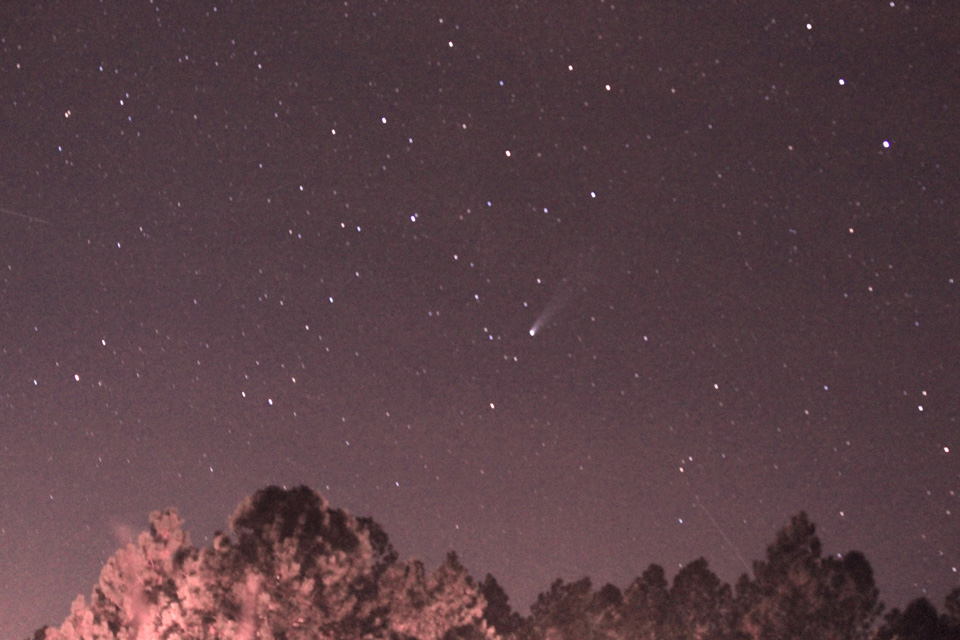
The moon is now entering the evening sky and will soon begin interfering with observations of the evening comets. I probably won't try to observe Comet Lemmon during this period, but once the moon has cleared from the evening sky (second week of November) I may look for it again; it will be quite low in the southwestern sky, but if it maintains something close to its present brightness as it pulls away from Earth it might still be a worthwhile object for perhaps a week or so after that before it disappears into the twilight.
MOST RECENT OBSERVATION: 2025 October 26.07 UT, m1 = 3.9, 1 degree tail (naked eye); 5' coma, DC = 6-7, 4 degree tail in p.a. 040 (10x50 binoculars)
766. COMET SWAN C/2025 R2 Perihelion: 2025 September 12.84, q = 0.504 AU
Up until a couple of decades ago it sometimes happened that a comet would approach the inner solar system from behind the sun (as seen from our vantage point here on Earth) and then unexpectedly spring into view, already bright and fully developed. With the advent of the comprehensive sky surveys this type of event has all but vanished, since even those comets that remain hidden in sunlight as they approach perihelion are usually discovered several months ahead of time as faint and distant objects, and thus even if we can't see them for a while we're nevertheless aware of their existence, and we're not surprised when they eventually do become visible. This particular comet, however, shows that it is still possible for such an event to happen, even if it is very rare nowadays.
The comet was first noticed by researcher Vladimir Bezugly in Ukraine in early September 2025, in images taken with the all-sky SWAN ultraviolet telescope aboard the SOHO spacecraft beginning on September 5. He then asked fellow researcher Martin Masek in the Czech Republic to attempt a ground-based confirmation, and when Masek was able to obtain images on the evening of the 11th via a remotely-operated telescope in Chile Bezugly's object was revealed as a bright comet, near magnitude 7 1/2, with a distinct ion tail over two degrees long. Numerous observers throughout the southern hemisphere soon began observing and imaging the new comet, and meanwhile additional images of it in SWAN images back to early August, and in images taken by the Heliospheric Imager aboard the STEREO-A spacecraft back to mid-August, were soon identified. The comet failed to appear in ground-based survey images taken in mid-June -- after which the elongation shrunk below the areas that most surveys are able to cover -- which suggests it might have undergone an upsurge in brightness sometime shortly before Bezugly detected it.
Comet SWAN's relatively small elongation after its discovery -- just under 30 degrees -- and its location south of the sun precluded any possibility of my observing it then. The elongation has steadily increased since then, and meanwhile the comet underwent an outburst to 6th magnitude in late September, and maintained that brightness for the next couple of weeks. After waiting out the full moon, and then some nights of rainy and cloudy weather, I finally had some relatively clear skies on the evening of October 10, and despite the fact that the conditions were not ideal I was nevertheless easily able to see the comet in 10x50 binoculars as a large, diffuse object, still near 6th magnitude. I could not really detect any tail -- no surprise given the conditions, and the fact that the comet has not developed any significant dust tail.
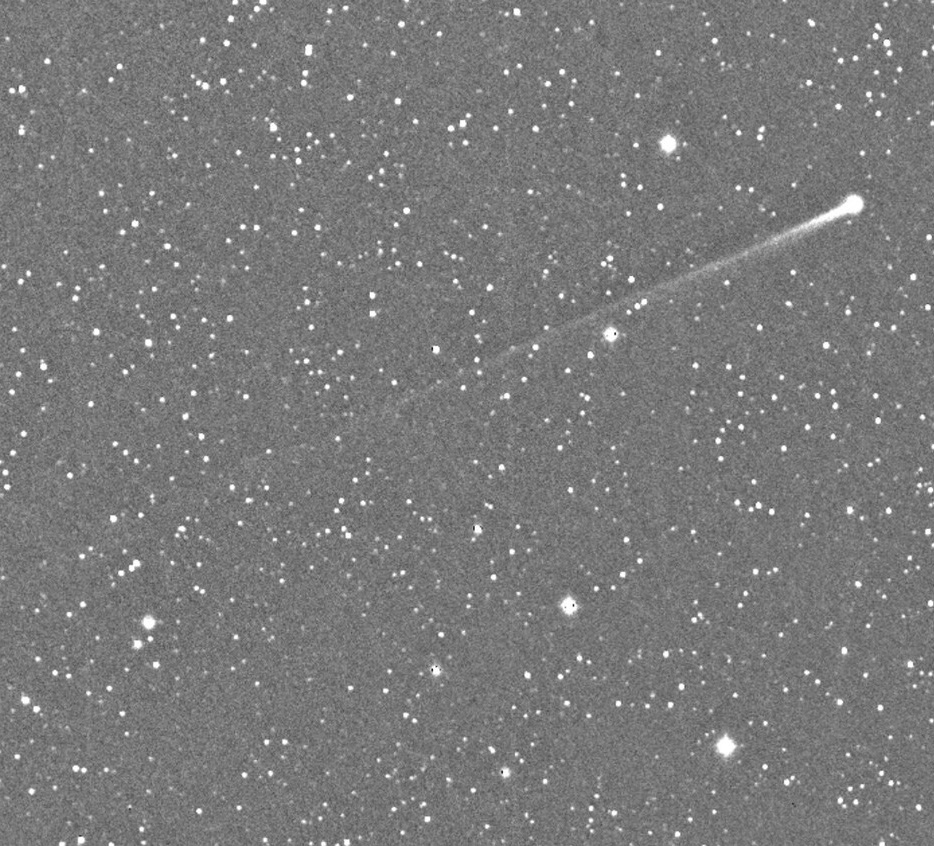
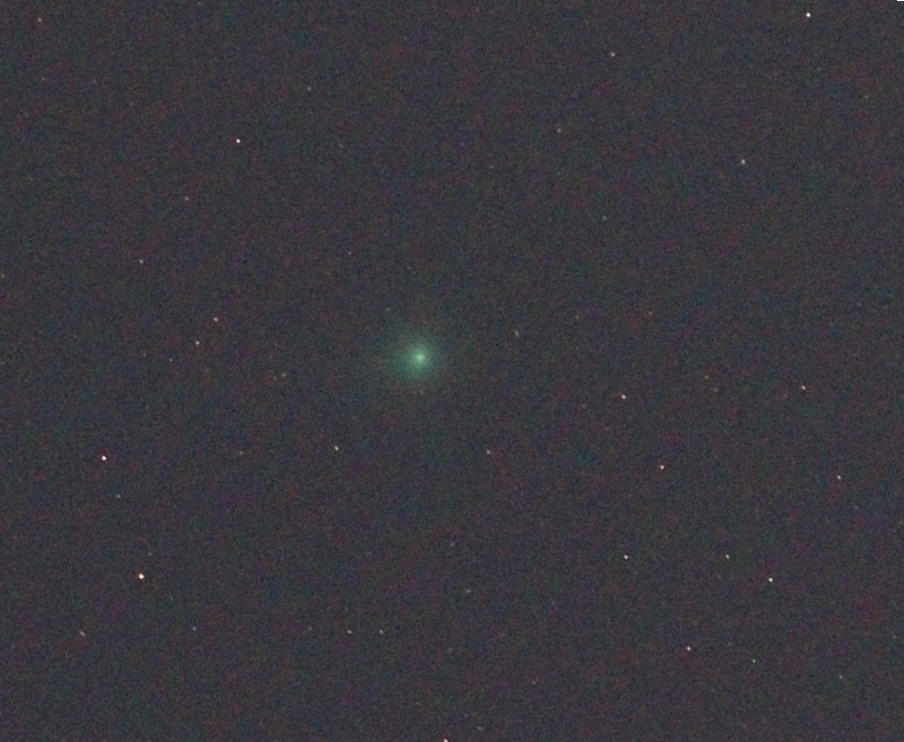 LEFT: One of the ground-based confirmation images of Comet SWAN, taken by Martin Masek via a remotely-controlled telescope located at the Cherenkov Telescope Array Observatory in northern Chile on September 11, 2025. Courtesy Martin Masek. RIGHT: Comet SWAN as imaged by Rob Kaufman from near Bright, Victoria on October 10, 2025. The appearance in this image is quite similar to what I observed in 10x50 binoculars later that same night. Image used with permission.
LEFT: One of the ground-based confirmation images of Comet SWAN, taken by Martin Masek via a remotely-controlled telescope located at the Cherenkov Telescope Array Observatory in northern Chile on September 11, 2025. Courtesy Martin Masek. RIGHT: Comet SWAN as imaged by Rob Kaufman from near Bright, Victoria on October 10, 2025. The appearance in this image is quite similar to what I observed in 10x50 binoculars later that same night. Image used with permission.
Comet SWAN is traveling in a low-inclination orbit (4.5 degrees -- unusually low for a long-period comet) and apparently has an approximate orbital period of 750 years. It has been approaching Earth ever since its discovery, and will pass 0.26 AU from our planet on October 20. It is currently located in far southern Serpens Cauda near the star Xi Serpentis and, having passed its farthest south point (declination -16.6 degrees) a few days ago, is now traveling towards the east-northeast, presently at 4 degrees per day but increasing as it continues approaching Earth. Within a couple of days it starts crossing the rich Milky Way star fields in Scutum, and at the time of closest approach will be located in southeastern Scutum and traveling at a peak rate of almost 5 degrees per day. After that it starts slowing down as it begins receding from Earth, to 2.5 degrees per day at the end of October and to one degree per day by mid-November; during this time it crosses southern Aquila and central Aquarius and will have entered Pisces, where it remains for the rest of 2025.
As is true for any long-period comet, brightness expectations for Comet SWAN are a bit problematical. It may remain somewhat close to its present brightness up through the time of its closest approach to Earth, but I suspect it may begin to fade pretty rapidly after that. It may remain bright enough to see in binoculars until perhaps early November, and thereafter remain visually detectable until sometime in December.
If Comet SWAN does maintain its present brightness near 6th magnitude for another week or so, especially as it climbs higher into the northern hemisphere's evening sky, it is conceivable that we may have the rare sight of two naked-eye comets simultaneously visible in the sky. Comet Lemmon C/2025 A6 (no. 765) has now crossed the naked-eye threshold, and is starting to become visible in the evening sky (and indeed has already done so for observers at latitudes north of me, and that should become true for me within a few nights). Thus far there have been two occasions when I have seen two comets simultaneously with my naked eye: in late April 2004 with Comets LINEAR C/2002 T7 (no. 338) and Bradfield C/2004 F4 (no. 350), and in late December 2007 with Comets 17P/Holmes (no. 414) and 8P/Tuttle (no. 415).
INITIAL OBSERVATION: 2025 October 11.08 UT, m1 = 6.1, 11' coma, DC = 4-5 (10x50 binoculars)
767. COMET WIERZCHOS C/2024 E1 Perihelion: 2026 January 20.77, q = 0.566 AU
Throughout all the decades I have been observing comets, my friendships with the various members of the international comet "community" have been very important to me. One of the newer members of this "community," with whom I became friends a few years ago (even though we have never met in person), is Kacper Wierzchos, a native of Poland who later emigrated to Spain and then the U.S., and after completing his Ph.D. at the University of South Florida in 2019 later that year began working with the Catalina/Mount Lemmon Survey in Arizona. He discovered his first comet late that year, a faint periodic object (P/2019 Y3) that was nevertheless assigned the name "Catalina;" it returned early this year (and has now been numbered as Comet 499P) under favorable geometrical conditions, and while it never became bright enough for visual attempts, I succeeded in imaging it with the Las Cumbres Observatory network on several occasions.
During his time with the Catalina/Mount Lemmon Survey Kacper has discovered numerous asteroids, the most notable of these (which he co-discovered with Theodore Pruyne in February 2020) being 2020 CD3, which turned out to be a tiny temporary "moon" of Earth (and which I discuss near the end of one of my presentations in "Ice and Stone 2020"). As of this writing he has discovered 7 comets that have received his name, the first of these being C/2020 H3 in April 2020, a faint and relatively distant long-period object.
Like the large majority of comets discovered by the comprehensive survey programs these days, most of Kacper's other comets have also been faint and/or distant objects. His fifth comet, which he discovered on March 3, 2024, during the course of the Mount Lemmon survey, has, however, turned out to be much more interesting. It was a relatively faint object of 20th magnitude when discovered, and was found to be located just over 8.0 AU from the sun, almost two years away from perihelion passage which would take place at a rather small heliocentric distance, which in turn suggested the potential of a bright, possibly naked-eye, display. Observations and calculations since then suggest that it is likely a first-time visitor from the Oort Cloud (although the gravitational perturbations it will encounter during its passage through the inner solar system will place it into an elliptical orbit with an approximate period of 200,000 years), and observations obtained in June 2024 with the James Webb Space Telescope suggest that it is significantly depleted in carbon monoxide and thus has a rather unusual chemical composition as far as comets go.
I began imaging Comet Wierzchos with the LCO network just a few days after its discovery, and did so on an occasional basis for the next couple of months. After it went through conjunction with the sun (63 degrees north of it) in early December 2024 I began imaging it again in March 2025, and have continued doing so on a semi-regular basis ever since. It seemed to brighten fairly dramatically during the middle months of this year, to the point where I made a visual attempt in late August -- unsuccessfully. (This was my first unsuccessful visual comet observation since my "retirement," and my intent has been that these would be very few in number.) The comet seemed to stagnate in its brightness for a while after that, but some images I obtained shortly before mid-October suggested it might be worth attempting again, and on the evening of the 15th I successfully detected it as a faint, somewhat "solid" object of 13th magnitude.

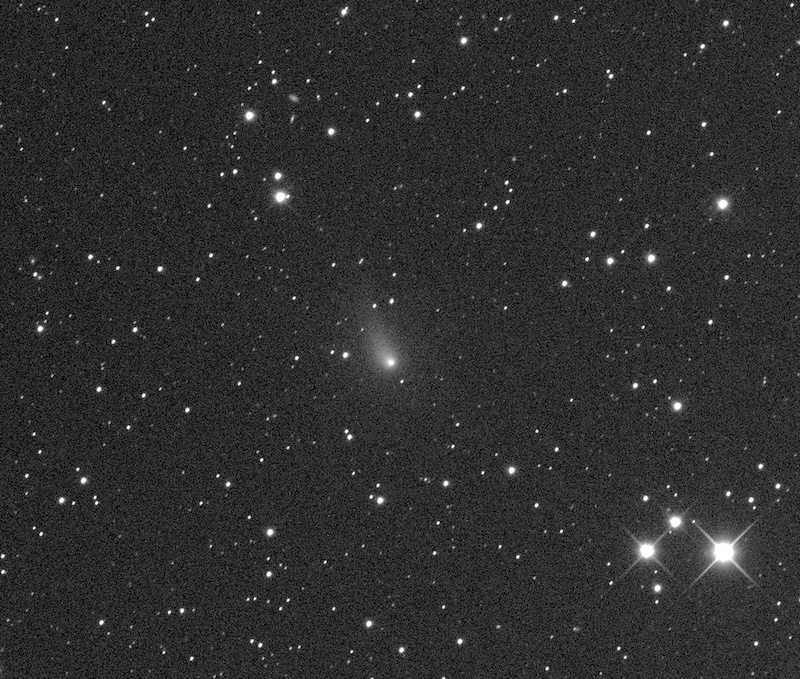 Images of Comet Wierzchos I have taken via the Las Cumbres Observatory network. LEFT: March 7, 2024 -- four days after the comet's discovery -- with a 1-meter telescope at the LCO facility at Teide Observatory in the Canary Islands. RIGHT: October 11, 2025 -- a little over four days before my first successful visual observation -- with one of the LCO 35-cm telescopes, also at Teide Observatory.
Images of Comet Wierzchos I have taken via the Las Cumbres Observatory network. LEFT: March 7, 2024 -- four days after the comet's discovery -- with a 1-meter telescope at the LCO facility at Teide Observatory in the Canary Islands. RIGHT: October 11, 2025 -- a little over four days before my first successful visual observation -- with one of the LCO 35-cm telescopes, also at Teide Observatory.
Comet Wierzchos is currently located in southwestern Hercules 1 1/2 degrees east of the star Omega Herculis, and is traveling towards the southeast at slightly over half a degree per day. It crosses into Ophiuchus in early November, and meanwhile its elongation, already down to 49 degrees, decreases fairly rapidly, and by about mid-November the comet will be disappearing into evening twilight. While it is never quite in conjunction with the sun, its elongation remains small for several weeks, as it passes just over 5 degrees east of the sun on December 28, and for almost two weeks should be visible in the LASCO C3 coronagraph aboard the SOHO spacecraft.
By the latter part of January 2026 Comet Wierzchos should be emerging into the southern hemisphere's evening sky, and it reaches a peak southerly declination of -43 degrees at the end of January when it will be located 1 1/2 degrees northwest of the Delta Gruis pair of stars. It then starts traveling rapidly towards the northeast as it crosses through Phoenix and Sculptor (passing one degree northwest of the bright galaxy NGC 55 on February 10 and less than 10 arcminutes northwest of the center of the Sculptor Dwarf Galaxy five days later) and will be closest to Earth, 1.01 AU, on February 17 when it will be traveling at 2 1/4 degrees per day. The comet crosses through southwestern Cetus in late February and enters Eridanus near the beginning of March, then crosses into Taurus in the middle of that month. Meanwhile, by the latter part of February it will have become accessible again from the northern hemisphere, and it will remain so as it travels through Taurus and (beginning during the second week of May) Gemini, around which time it is also disappearing again into evening twilight.
Brightness projections that were made soon after Comet Wierzchos' discovery suggested it might become as bright as 5th or 6th magnitude around the time of perihelion and the next few weeks afterwards, and could still be as bright as 7th or 8th magnitude when it becomes accessible from the northern hemisphere. The fact that it is currently running 1 to 1 1/2 magnitudes fainter than the original projections, plus the fact that it appears to be a "new" comet from the Oort Cloud, and perhaps even its apparently unusual chemical composition, all seem to suggest that those earlier projections are probably too optimistic. At this writing, a peak brightness of about 8th magnitude, possibly 7th, seems somewhat realistic, and accordingly it might be around 9th to 10th magnitude when I'll be able to access it again after it comes back north. As is always the case with long-period comets, we'll just have to wait and see what this one does.
In a conversation I had with Kacper a few months ago I told him that, even though I am now "retired" from systematic visual observing, I would nevertheless drag my telescope out to observe "his" comet, and I was happy to inform him a couple of days ago that I had indeed successfully done so. Whether or not I will see it again before it disappears into the dusk next month remains to be seen, but I am cautiously optimistic that I will be able to observe it at least a couple of times after it comes back north next year. Kacper has told me that he has tentative plans to travel to the southern hemisphere around the time of its perihelion passage provided that it becomes bright enough to warrant doing so, and I hope that "his" comet performs well enough so that this would be a worthwhile and successful endeavor for him.
INITIAL OBSERVATION: 2025 October 16.08 UT, m1 = 13.3, 1.5' coma, DC = 3-4 (41 cm reflector, 229x)
768. COMET ATLAS C/2025 T1 Perihelion: 2025 December 2.37, q = 1.109 AU
In a recent update to one of my previous tally entries, I mentioned a sad event taking place in my personal life. I was referring to the death of my father-in-law, Donald Stone, who passed away in our home on October 27, at the age of 94. He had been living with us since mid-2020, and up until the fairly recent past had been in as good a health as one could reasonably expect someone of his age to be, but had been showing an obvious deterioration in health during recent weeks. He was a pleasant person to have around, and I am most grateful to him for providing me with Vickie, with whom I have at long last found happiness and contentment in my romantic life.
As was, coincidentally, the case for both my mother and my father, there was a decent naked-eye comet in the sky at the time of Donald's passing. Even more interesting, there was also a naked-eye comet in the sky when he was born: Comet Ryves 1931c, which was only visible for a period of ten days between the time of its discovery and the time it disappeared into the dawn en route to perihelion, a period which included Donald's birth. To somewhat paraphrase the American writer Samuel Clemens, aka Mark Twain, Donald came in with a bright comet, and is going out with a bright comet.
In sharp contrast to the situation that was extant earlier this year, the current level of cometary activity is quite high, and despite my so-called "retirement" I have actually been fairly busy in comet observing lately (although still significantly less so than I would have been under similar circumstances during previous years). I may, or may not, have observed this particular comet without the present level of activity, but since I would have been outside anyway observing other comets, I decided to go ahead and take a look at it. It was discovered on October 11, 2025 by the ATLAS program's telescope at Mauna Loa in Hawaii, at which time it was located fairly low in the northeastern sky before dawn and close to 17th magnitude. The comet traveled northward and eastward after that, passing through conjunction with the sun (70 degrees north of it) in early November -- at which time it was near its farthest north declination near +55 degrees -- and thereafter turned towards the southeast and entered the evening sky. Meanwhile, various reports I read and images I saw indicated it had rapidly brightened, and when I looked for it on the evening of November 10 I easily detected it as a diffuse but distinctly condensed object of 10th magnitude.
At this writing Comet ATLAS is near its closest approach to Earth (1.02 AU) and is presently located in northern Hercules a couple of degrees north-northwest of the globular star cluster M92, still traveling towards the southeast at a little over two degrees per day (although gradually slowing down). It crosses into southwestern Lyra a week from now and then into Vulpecula at the end of November, and after passing directly over the "Coathanger" star cluster (Collinder 399) on December 4 crosses into Sagitta a day later and then into Aquila a couple of days after that, passing north of the "head" of that constellation in mid-December and remaining in that constellation until the end of 2025, at which time it is entering evening twilight. For whatever it's worth, the comet passes almost directly behind the sun on February 10, 2026.
In my reduced state of astronomical observing I may, or may not, see Comet ATLAS again. Since it will now begin pulling away from Earth and is just a couple of weeks away from perihelion passage I doubt if it becomes much brighter, and since the level of evening-sky comet activity is now decreasing pretty rapidly I don't really see myself dragging the telescope out for just this object. Of course, if I read of some unexpected brightening of other unusual activity I can always revisit these plans.
As a result of some recent strong solar flares, New Mexico witnessed a rare aurora display on Tuesday evening, November 11. I was able to see this from the road in front of my residence, although the reddish coloration was only faintly detectable to the naked eye; I have seen more impressive aurora displays from these parts in the past, although on the other hand this was the first aurora I had seen in over twenty years. Meanwhile, on the personal front my older son Zachary, and my grandson Santiago Ezekiel, are visiting from Australia for the next couple of weeks, and I am always grateful for the rare opportunity to spend time with them.

LEFT: Donald Hugh Stone (August 13, 1931 -- October 27, 2025). RIGHT: A photograph I took of the aurora on November 11, 2025, from the road in front of my residence. Hand-held (!) exposure of 3 seconds.
INITIAL OBSERVATION: 2025 November 11.08 UT, m1 = 10.3, 4.5' coma, DC = 5 (41 cm reflector, 70x)
769. COMET 3I/ATLAS I/2025 N1 Perihelion: 2025 October 29.48, q = 1.356 AU
From a scientific standpoint, this is definitely a "comet for the ages." Together with the recent naked-eye Comet Lemmon C/2025 A6 (no. 765) and perhaps a few of my other recently-added comets above, this comet is definitely challenging my recent "retirement" and sending me outside for observations rather more frequently that I had envisioned.
The comet was discovered on July 1, 2025, by the ATLAS program's telescope in Chile. At that time it was about 18th magnitude and just a few days past opposition, traveling almost due westward through rich Milky Way star fields in Sagittarius (although it was fortuitously situated against some of the Milky Way's dust lanes at the time). The ATLAS discovery was placed on the Minor Planet Center's Near-Earth Object Confirmation Page (NEOCP) shortly thereafter, and later that same day I was able to obtain some confirmation images with one of the Las Cumbres Observatory (LCO) network's telescopes at Teide Observatory in the Canary Islands. These images showed the object as being essentially stellar, with perhaps just the slightest hint of diffuseness. The astrometry from these images was listed on the comet's official discovery announcement.
Within pretty short order numerous pre-discovery images were identified, including with the ATLAS telescopes back to June 24, and eventually to as far back as May 8 in images obtained by the Transiting Exoplanet Survey Satellite (TESS) spacecraft. What the resulting orbital calculations revealed was incredible: Comet ATLAS is traveling on a strongly hyperbolic orbit with an eccentricity as high as 6.1, which can only mean one thing, i.e., it is an interstellar object arriving from somewhere else in the Galaxy. It is the third such object that has been discovered within recent years, following the object 1I/‘Ouamuamua in 2017 and Comet 2I/Borisov I/2019 Q4, which I was able to observe a couple of times (no. 670) at the extreme limit of visibility of the 41-cm telescope. Comet ATLAS' eccentricity is almost twice as high as that of either of those two objects, and some studies suggest that it may have come from the Galaxy's "thick disk," i.e., from very old stars, and thus may be two billion or more years older than our solar system.
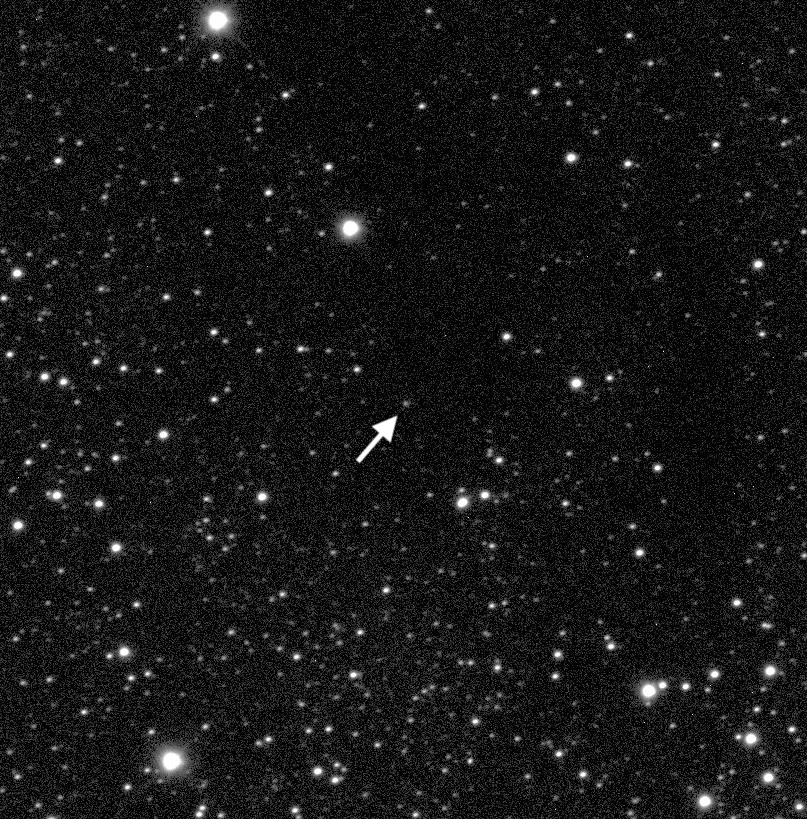
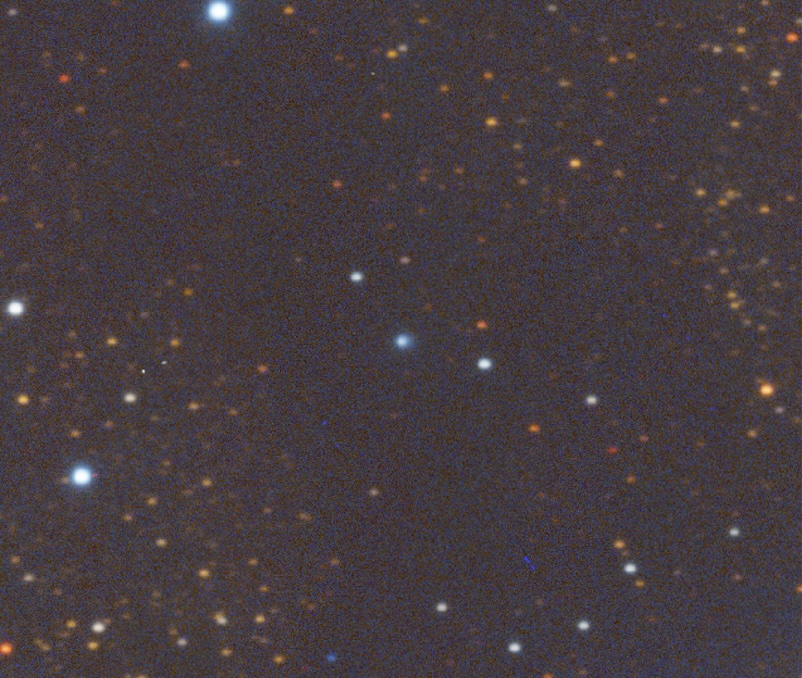 LEFT: One of the confirmation images of Comet 3I/ATLAS I obtained on July 1, 2025, only 17 hours after the comet's discovery, via the Las Cumbres Observatory (LCO) facility at Teide Observatory in the Canary Islands. The astrometry from these images was included on the comet's discovery announcement. RIGHT: A synthetic composite color image of Comet 3I/ATLAS obtained July 4, 2025 by Tim Lister with the LCO 2-meter telescope at Haleakala Observatory in Hawaii. Courtesy Tim Lister/LOOK Project/LCO.
LEFT: One of the confirmation images of Comet 3I/ATLAS I obtained on July 1, 2025, only 17 hours after the comet's discovery, via the Las Cumbres Observatory (LCO) facility at Teide Observatory in the Canary Islands. The astrometry from these images was included on the comet's discovery announcement. RIGHT: A synthetic composite color image of Comet 3I/ATLAS obtained July 4, 2025 by Tim Lister with the LCO 2-meter telescope at Haleakala Observatory in Hawaii. Courtesy Tim Lister/LOOK Project/LCO.
Comet ATLAS's orbit is almost in the plane of the ecliptic, but retrograde, with an inclination of 175 degrees. I continued to image it on a semi-regular basis with the LCO network and it brightened fairly rapidly; by late July it was appearing clearly cometary in the images, and by early September was exhibiting a distinct tail. By mid-September it had brightened to the point where I thought that visual attempts might be worthwhile, although on the other hand it was starting to get low in the southwestern sky after dusk; I did make one attempt on the evening of the 14th but couldn't convince myself I was seeing anything, although some images I saw that were taken around that time suggested I didn't miss it by much. The comet apparently underwent an upsurge in brightness shortly after my attempt, and there were in fact some successful visual observations reported from observers in the southern hemisphere, but by that time it was too low for me to make any additional attempts. Observers in the southern hemisphere continued to image the comet until just after the beginning of October, after which it disappeared into twilight en route to conjunction with the sun on the 21st of that month.
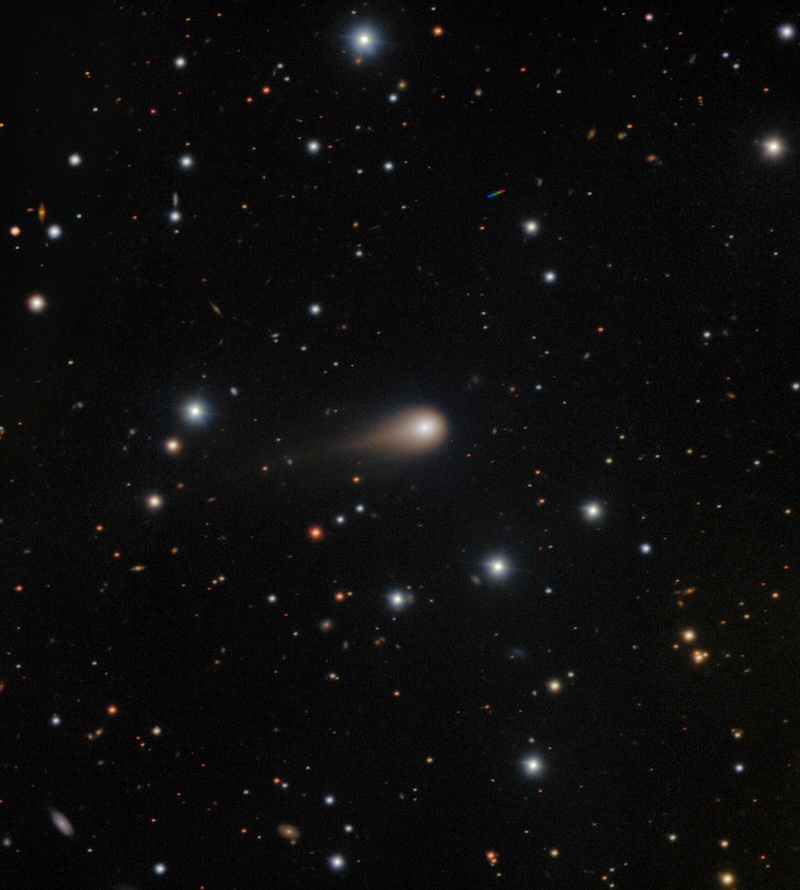
 LEFT: Image of Comet 3I/ATLAS obtained August 27, 2025 by the 8.1-meter Gemini South Telescope in Chile. Courtesy International Gemini Observatory/NOIRLab/NSF/AURA/Shadow the Scientist. RIGHT: Image of Comet 3I/ATLAS I obtained on September 17, 2025, from the LCO facility at Siding Spring Observatory in New South Wales. This is from the last set of images I obtained before the comet passed through conjunction with the sun.
LEFT: Image of Comet 3I/ATLAS obtained August 27, 2025 by the 8.1-meter Gemini South Telescope in Chile. Courtesy International Gemini Observatory/NOIRLab/NSF/AURA/Shadow the Scientist. RIGHT: Image of Comet 3I/ATLAS I obtained on September 17, 2025, from the LCO facility at Siding Spring Observatory in New South Wales. This is from the last set of images I obtained before the comet passed through conjunction with the sun.
Comet 3I/ATLAS was unobservable from Earth throughout most of October, however it passed only 0.19 AU from Mars on October 3 and was observed by various spacecraft both from Mars' surface and from Mars orbit. Other spacecraft that observed it include NASA's Psyche spacecraft, en route to its namesake asteroid, and NASA's Lucy spacecraft, en route to Jupiter's Trojan asteroids, and around the time it was in conjunction with the sun it was also observed by various orbiting coronagraphs.
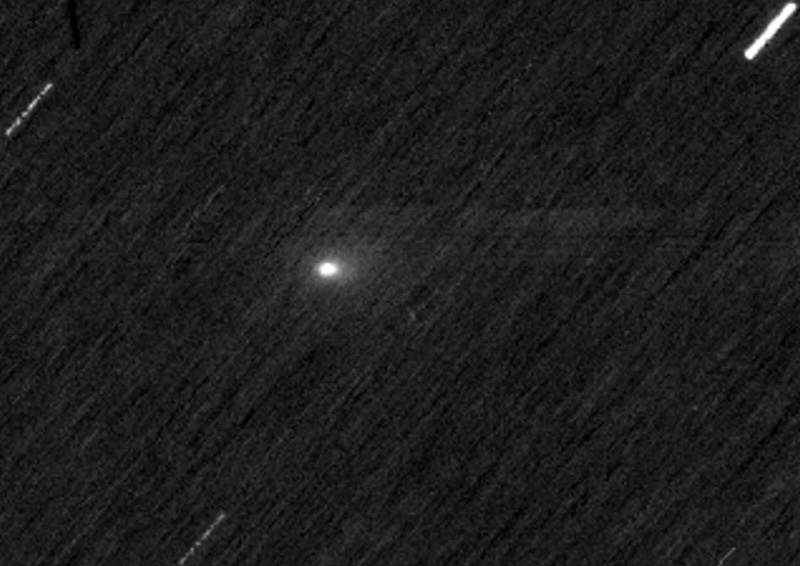
.jpg) LEFT: Comet 3I/ATLAS, imaged from Mars orbit by ESA's ExoMars Trace Gas Orbiter on October 3, 2025. Courtesy ESA/TGO/CaSSIS. RIGHT: A "stacked" set of images from the LASCO C3 coronagraph aboard SOHO taken October 23, 2025, showing Comet 3I/ATLAS. Courtesy NASA/ESA/Piotr Guzik.
LEFT: Comet 3I/ATLAS, imaged from Mars orbit by ESA's ExoMars Trace Gas Orbiter on October 3, 2025. Courtesy ESA/TGO/CaSSIS. RIGHT: A "stacked" set of images from the LASCO C3 coronagraph aboard SOHO taken October 23, 2025, showing Comet 3I/ATLAS. Courtesy NASA/ESA/Piotr Guzik.
The first post-perihelion ground-based images of Comet 3I/ATLAS were obtained on October 31 by the Lowell Discovery Telescope, at which time its elongation was only 16 degrees. Numerous observers around the world began obtaining images during the subsequent days as the elongation steadily increased, with most of these showing a faint but somewhat structured ion tail with indications of a short anti-tail. Since I have trees in that direction from my main observing location, and also due to moonlight, I didn't attempt any observations until the morning of November 14, but I then saw it easily as a diffuse but moderately condensed 10th-magnitude ordinary-looking comet. The comet's appearance was similar when I observed it again, slightly higher in a darker sky, three mornings later, and I suspected a short, broad, faint tail.
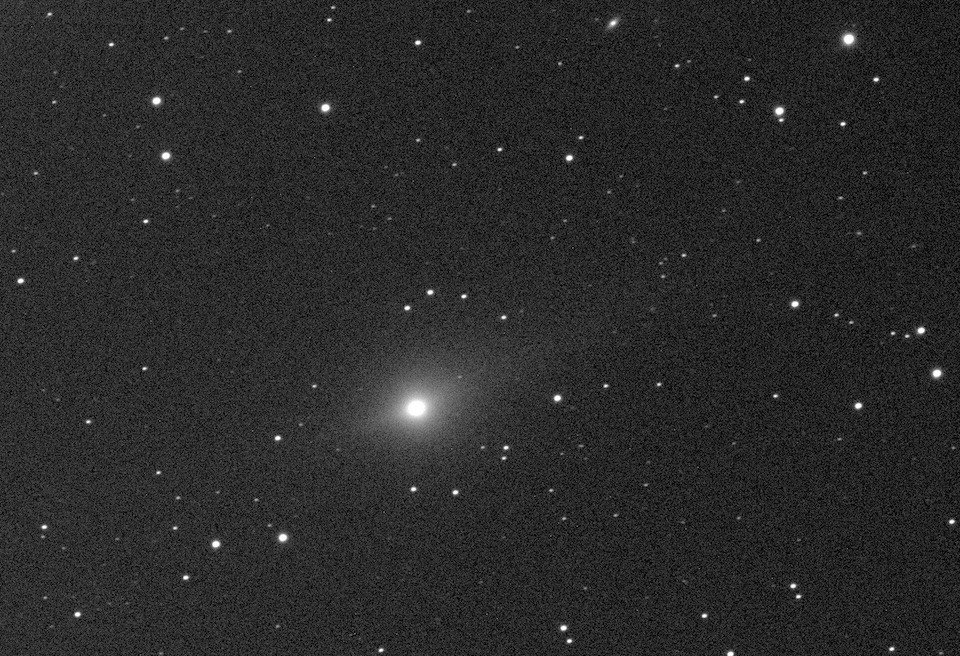 Image of Comet 3I/ATLAS I obtained on November 20, 2025, via the LCO network facility at Teide observatory in the Canary Islands.
Image of Comet 3I/ATLAS I obtained on November 20, 2025, via the LCO network facility at Teide observatory in the Canary Islands.
At this writing Comet 3I/ATLAS is located in western Virgo three degrees west-southwest of the star Gamma Virginis, and is traveling towards the west-northwest at approximately 45 arcminutes per day. It passes half a degree south of the star Eta Virginis on November 25 and a similar distance south of the star Beta Virginis on December 3 before crossing into Leo four days later, where it remains until the first week of January 2026, in the meantime passing slightly less than two degrees south of the bright star Regulus on December 27 (when it will be traveling at its peak rate of 1 1/4 degrees per day). The comet is nearest Earth (1.80 AU) on December 19 and will be at opposition on January 23, 2026, when it will be located half a degree southeast of the star Zeta Cancri. Afterwards it slows down as it recedes from the sun and Earth, crossing into Gemini in late January and reaching a stationary point shortly before mid-April, thereafter traveling slowly eastward as it disappears into evening twilight towards the end of May.
There is obviously very little to go on as far as predicting Comet 3I/ATLAS' future brightness is concerned, although I suspect that at this time it is probably pretty close to its peak brightness. It may fade by a magnitude or two by the end of 2025 and perhaps remain visually detectable for another one to two months after that, but will likely only be detectable via imaging with moderate-size telescopes by the time it disappears into the dusk. Large telescopes should still be able to detect it when it emerges into the morning sky about three months later, and I suspect that it will be kept under observation for as long as possible.
Comet 3I/ATLAS is presenting us with a probably once-in-a-lifetime opportunity to study, up close and personal, the conditions under which planetary systems have formed long ago and elsewhere in the Galaxy, and is going to be an object of intense study for at least the near-term future. While we might expect additional interstellar comets to be discovered during the coming years and decades, especially once the Legacy Survey of Space and Time conducted from the Vera C. Rubin Observatory in Chile becomes operational in the near future, it is quite unlikely that any of these will become as bright and as easy to study as this one currently is. Once it completes its passage through our solar system it will continue its wanderings through our Galaxy, perhaps encountering other planetary systems every few hundred million to billion years, until that time in the unimaginably distant future when the Galaxy itself no longer exists.
INITIAL OBSERVATION: 2025 November 14.51 UT, m1 = 9.8, 1.7' coma, DC = 4 (41 cm reflector, 70x)
770. COMET 24P/SCHAUMASSE Perihelion: 2026 January 8.10, q = 1.184 AU
As a part of my collaboration with the Global Sky Partners educators' forum of the Las Cumbres Observatory (LCO) I have occasionally attempted recoveries of incoming periodic comets from time to time. As of now I have successfully recovered five such comets, the first of these being 15P/Finlay during its return in 2021 (no. 702) and then, most dramatically, Comet 13P/Olbers in August 2023 en route to its perihelion passage the following year (no. 752). My third successful recovery was Comet 333P/LINEAR during its 2024 return (no. 759). Thus far during 2025 I have made two successful recoveries: the first of these was the relatively obscure Comet 351P/Wiegert-PANSTARRS, an object with a current orbital period of 9.4 years originally discovered by the Pan-STARRS program in August 2016 but later found to be identical to a comet reported in 2009 by University of Western Ontario astronomer Paul Wiegert on survey images taken by the Canada-France-Hawaii Telescope at Mauna Kea in September 2007. I successfully recorded it on May 22 with 1-meter LCO telescopes at Teide Observatory in the Canary Islands and at Cerro Tololo Inter-American Observatory in Chile, at which time it was a faint object near 20th magnitude; my recovery observations were published a month later. The comet had already passed through perihelion in late March at a heliocentric distance of 3.13 AU and it reached a peak brightness near 18th magnitude when it went through opposition in late July; I obviously never attempted it visually.
My second 2025 recovery was of a comet that is personally important to me and that I have seen on several previous returns, beginning in 1984 (no. 76). As I discuss in my write-up for its 2017 return (no. 631), I obtained my first observation of the comet in 1984 just a couple of days after learning of the death of my childhood best friend, Mark Bakke, whom I consider in several ways at least partially responsible for influencing me to pursue a career in astronomy, and ever since then I have always associated this particular comet with him. (In an event almost too eerie to be a coincidence, I obtained my final observation of P/Schaumasse in 2017 just a couple of days before the death of Mark's mother, Marie Bakke.) As I also mention in that write-up, the comet's current return is a distinctly favorable one, and as the time approached it began to occur to me that, as an homage to Mark, since I now have the capability to do so I could try to make the recovery this time around.
I began making recovery attempts in early July, and over the next few weeks I had a couple of false alarms wherein high-numbered main belt asteroids -- specifically, (135059) 2001 OX89 and then (161751) 2006 SU287 -- were close to the comet's expected position and mimicked its expected motion. Finally, on August 24 -- concidentally, the two-year anniversary of my recovery of 13P/Olbers and the one-year anniversary of my wedding -- I imaged a very faint (20th magnitude) moving object with one of the 35-cm LCO telescopes at Cerro Tololo that did not coincide with any known asteroid, and after obtaining additional images over the next couple of days at CTIO and with additional LCO telescopes at Teide Observatory and at McDonald Observatory in Texas the identity with P/Schaumasse seemed secure, and my various recovery observations were published by the Minor Planet Center a couple of weeks later.
I have continued to image P/Schaumasse with the LCO network on a semi-regular basis ever since then. It remained quite faint for some time thereafter, brightening only slowly, but by the beginning of October it was clearly cometary in the images, and by a month later it was beginning to exhibit a faint, diffuse outer coma. Over the next couple of weeks additional LCO images I took as well as images taken by other observers, along with other evidence including at least one reliable report of a visual sighting, suggested it was finally worthwhile for me to make a visual attempt, and on the morning of November 25 I successfully detected it as a vague and diffuse object between magnitudes 12 1/2 and 13.
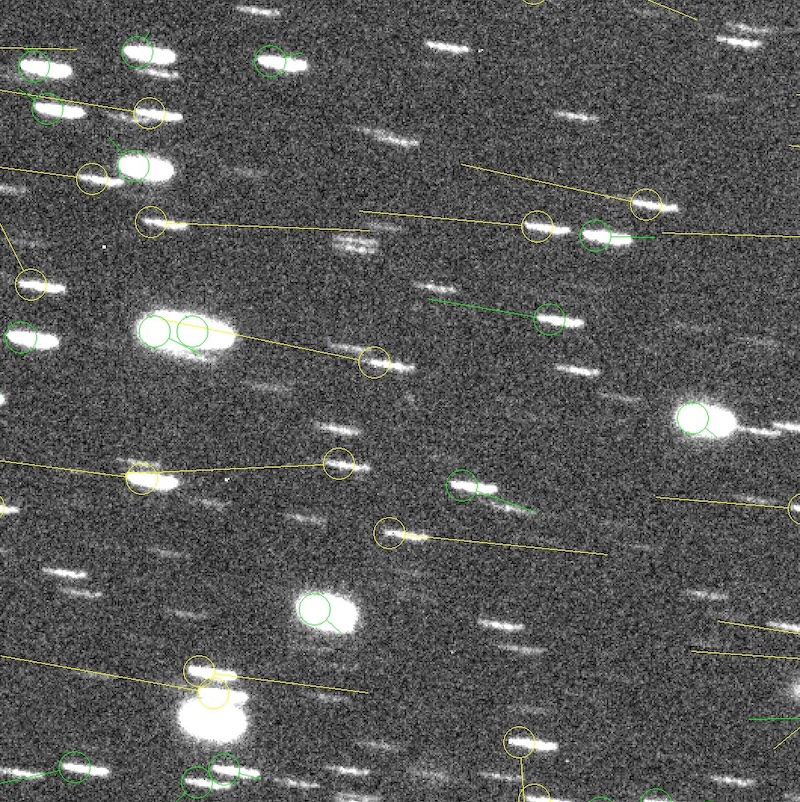
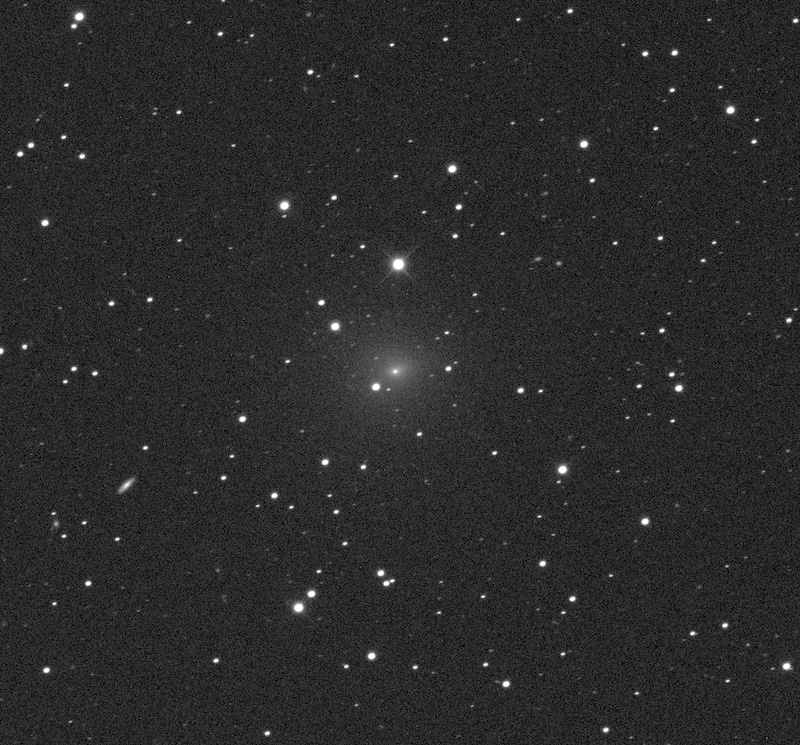 LEFT: Recovery of Comet 24P/Schaumasse. This is a "stack" of three 5-minute exposures I took on August 24, 2025 with one of the 35-cm Las Cumbres Observatory (LCO) telescopes at Cerro Tololo Inter-American Observatory in Chile. The comet is the faint, small object in the center. RIGHT: Comet 24P/Schaumasse on November 25, 2025, as imaged from the LCO facility at McDonald Observatory in Texas. I obtained this image at almost the exact same time as my first visual observation.
LEFT: Recovery of Comet 24P/Schaumasse. This is a "stack" of three 5-minute exposures I took on August 24, 2025 with one of the 35-cm Las Cumbres Observatory (LCO) telescopes at Cerro Tololo Inter-American Observatory in Chile. The comet is the faint, small object in the center. RIGHT: Comet 24P/Schaumasse on November 25, 2025, as imaged from the LCO facility at McDonald Observatory in Texas. I obtained this image at almost the exact same time as my first visual observation.
Comet 24P/Schaumasse is currently an early morning-sky object, being presently located in western Leo -- near the "head" of that constellation -- three degrees west of the star Gamma Leonis ("Algieba") and traveling just southward of due east at slightly over one degree per day, passing just over half a degree south of that star on December 1. In late December it crosses into southern Coma Berenices and traverses the northernmost regions of the Virgo Cluster of Galaxies (passing 20 arcminutes south of the galaxy M100 on December 26), then crosses into Virgo just before its closest approach to Earth (0.59 AU) on January 4, 2026. Continuing its generally eastward trajectory (albeit gradually curving more southward), the comet crosses into southern Bootes a week later, back into Virgo after a month, and then into Serpens Caput shortly after mid-February. After passing through its stationary point on March 12 it begins traveling towards the west-southwest, crossing back into eastern Virgo in early April; it is at opposition at the beginning of May and reaches its other stationary point on June 9.
As I've previously indicated, this return of P/Schaumasse is a distinctly favorable one, comparable to what I consider to be the best one I've seen, that of 1993 (no. 174). Based upon its performance during previous returns, it should reach a peak brightness near 9th magnitude during January 2026, and may remain visually detectable for another two months or so after that. In my current state of limited visual observing I probably won't be looking at it very often, but in homage to my long-ago friend I certainly plan to grab at least two or three observations when it's brightest. After that, I may very well not be seeing this comet again; while the next return, in 2034 (perihelion mid-March), is also a relatively favorable one, with a minimum distance from Earth of 0.77 AU, whether or not I'm still observing comets at any level by that time is rather questionable, at best.
Mark's legacy lives on ways other than this comet. I gave my older son Zachary, born in early 1987 -- 2 1/2 years after Mark's death -- the middle name of "Mark" in honor of my deceased friend. Zachary, now 38 years old, has been living in Australia for the past few years, and became a father himself a year and a half ago (as I recounted in a pair of tally entries I wrote at that time). He, and my grandson Santiago Ezekiel, have been visiting here in New Mexico for the past couple of weeks, but are now on their way back to Australia. Because of the large distances involved I don't get to see Zachary and Santiago very often, but I hope I can continue to do so at least once in a while during the years to come; meanwhile, my younger son Tyler and his family (i.e., my daughter-in-law Sara, granddaughter Avery, and grandson Ethan) live relatively nearby, and I do get to share precious visits with them from time to time.
 Zachary, Santiago Ezekiel, and me, November 26, 2025, shortly before their return to Australia.
Zachary, Santiago Ezekiel, and me, November 26, 2025, shortly before their return to Australia.
INITIAL OBSERVATION: 2025 November 25.41 UT, m1 = 12.8, 1.4' coma, DC = 1-2 (41 cm reflector, 229x)
<-- Previous
Next -->
BACK to Alan's Comet Page